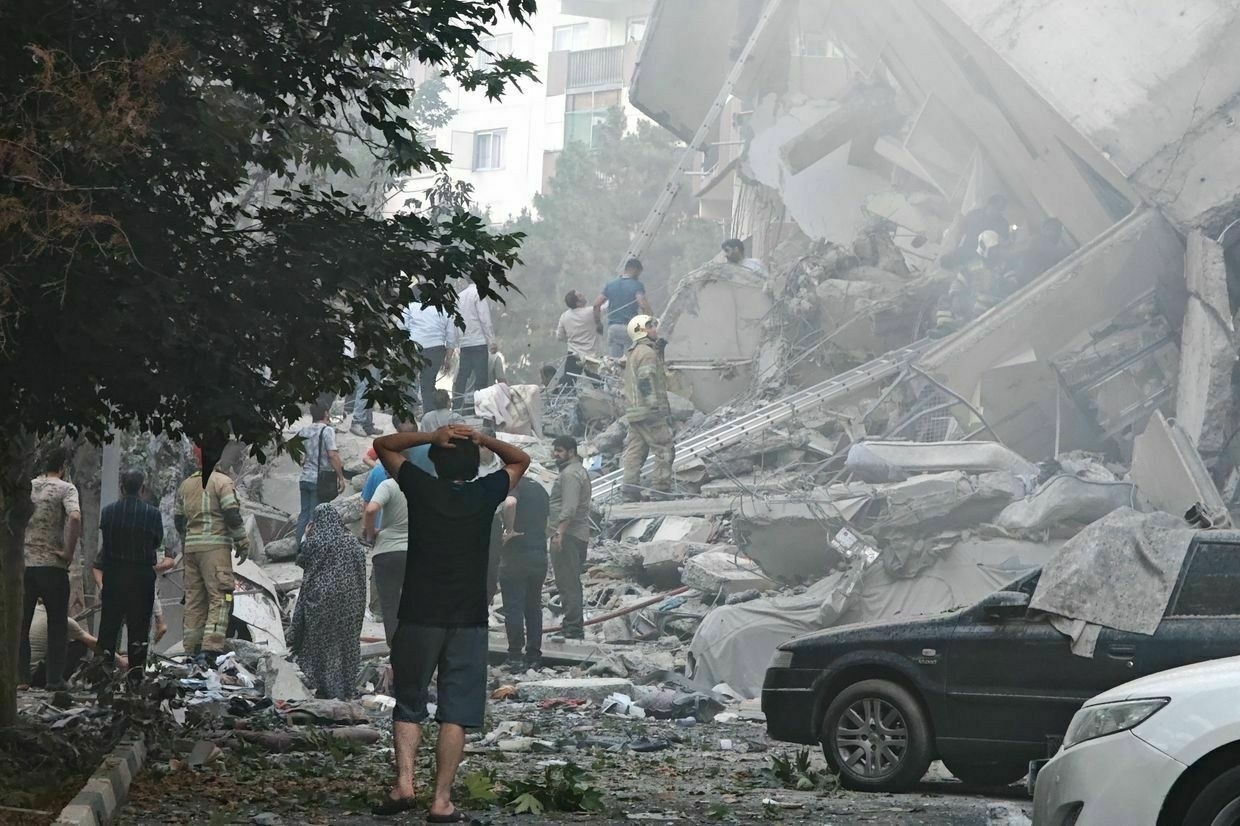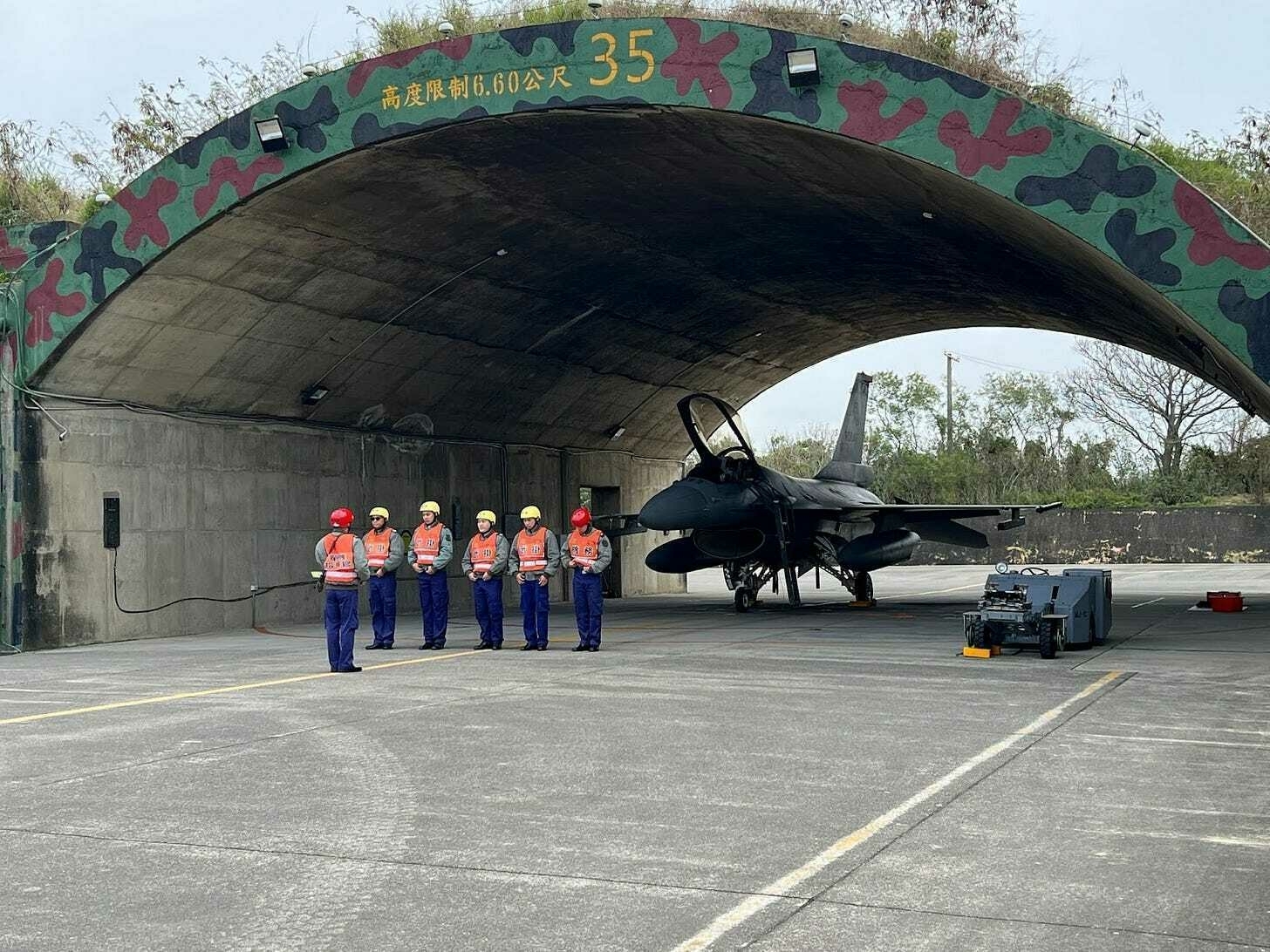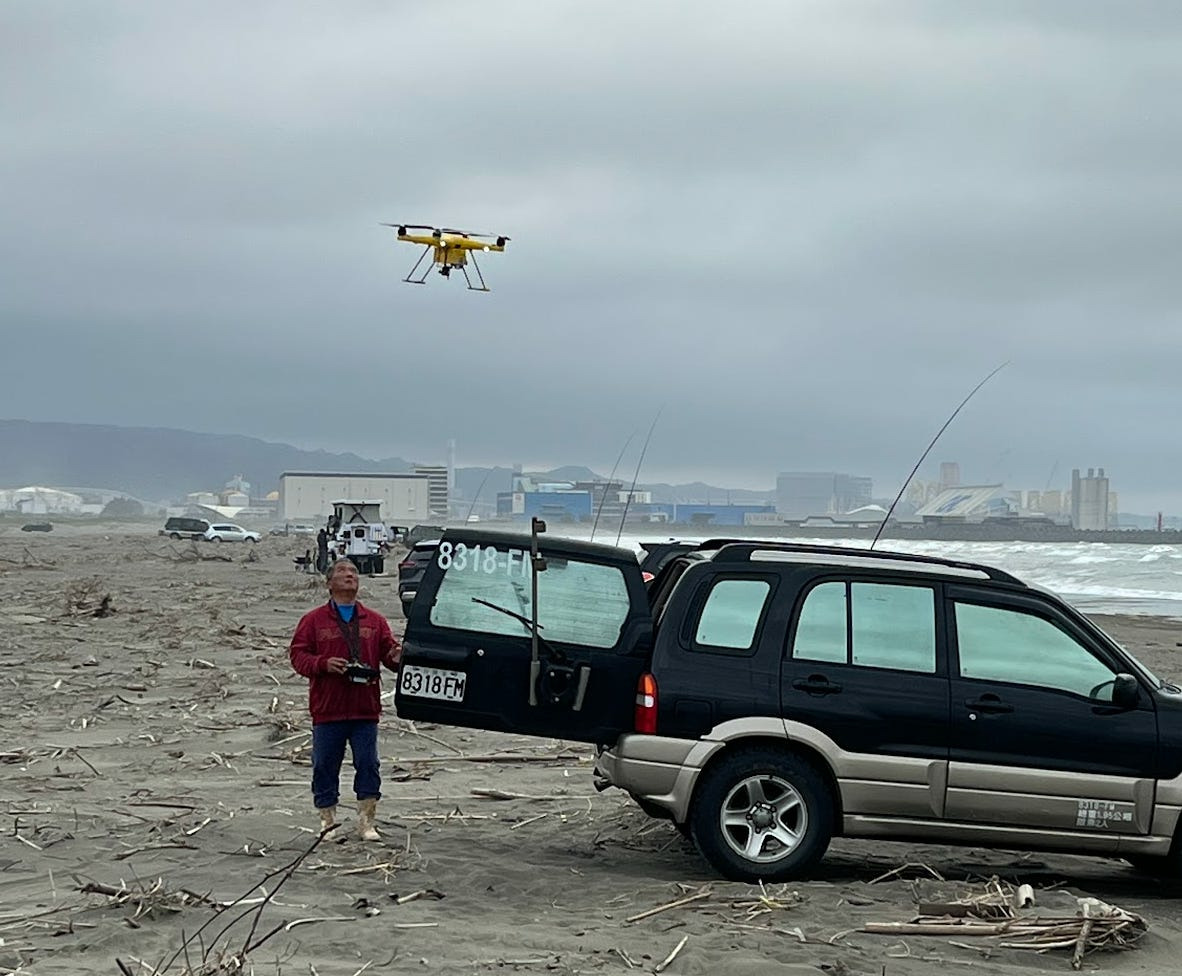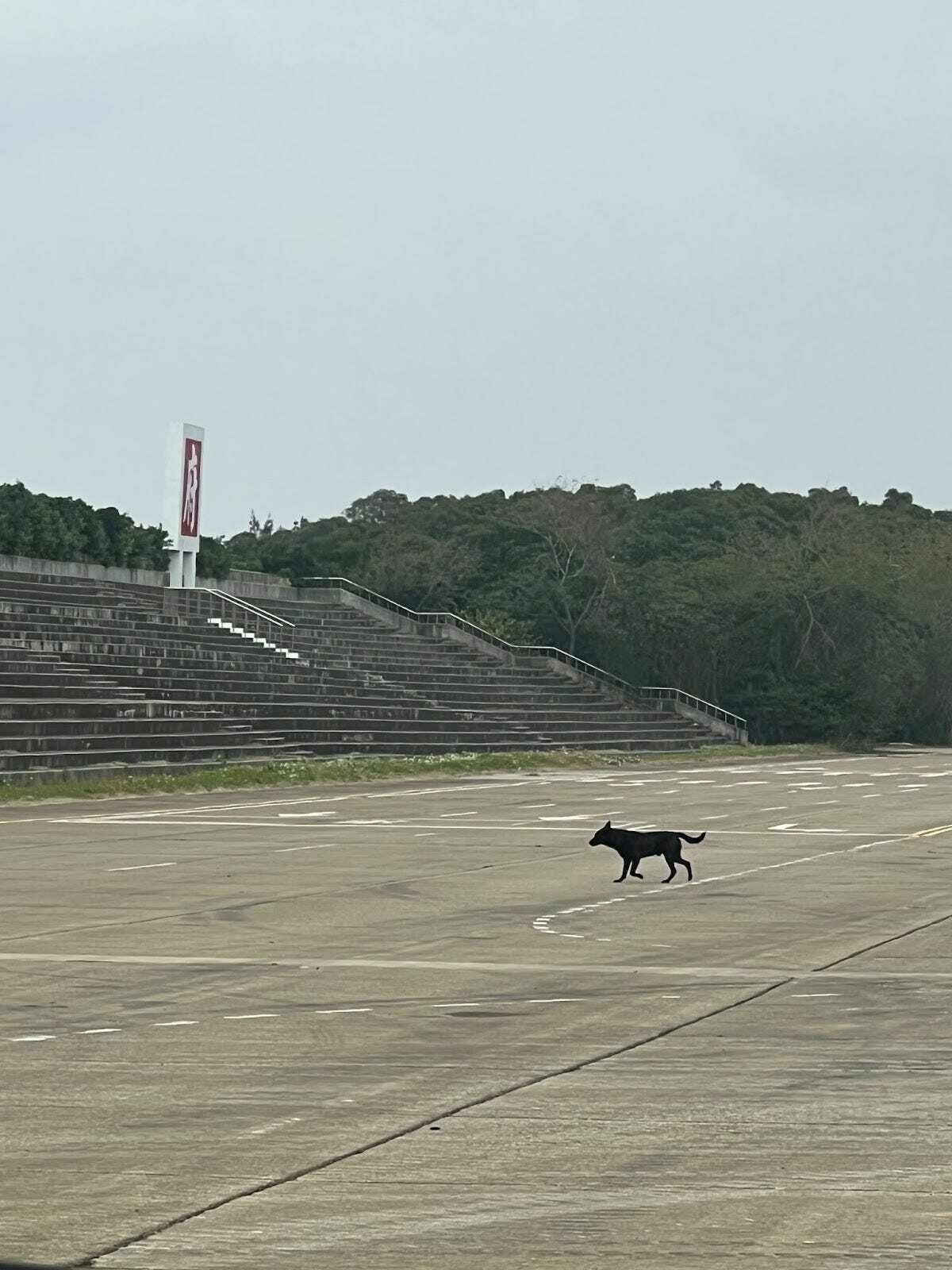-
Ukrainian drones target key Russian industrial sites in Samara and Stavropol regions
Two major industrial sites involved in the production of explosives and ammunition in Russia were hit by Ukrainan drones, reported the Ukrainian Armed Forces' General Staff on June 14.
In the early hours of Saturday, June 14, drones struck the "Nevinnomyssk Azot" chemical plant in the Stavropol region and the Novokuibyshevsk Catalysts Plant in the Samara region. "Nevinnomyssk Azot," part of the EuroChem group, stands as Russia's largest producer of ammonia and nitrogen fertilizers.
Operations were reportedly carried out by Unmanned Systems Forces, in coordination with other Defense Forces components.
"Facilities at JSC NNK in Russia's Samara region have been compromised. This is a leading enterprise in the production of explosive components, categorized as a defense industry facility in Russia. Explosions and a fire occurred within the industrial area," stated the General Staff.
Earlier on Saturday, drones targeted the Nevinnomyssk Nitrogen Plant in Russia's Stavropol region, where ammonia and ammonium nitrate, essential for explosives and artillery shells, are produced.
"The plant plays a major role in supporting Russia's armed aggression against Ukraine. Reports indicate a series of explosions and enemy anti-aircraft defense activities at the target's vicinity, with a fire recorded in the industrial zone. The effects of the strike are being clarified," the General Staff added.
The facility has the capacity to produce approximately 1 million tons of ammonia, 1.4 million tons of ammonium nitrate, and 0.89 million tons of urea annually.
Local residents shared videos on social media capturing fires that broke out after the drone strike—this contradicts major Russian media reports that the UAV attack was thwarted.
-
Fourth exchange in a week! Ukrainian defenders return home #shorts
-
The ‘Red Beaches’ of a Taiwan invasion
Editor’s Note:
Editor’s note: June has historically been our toughest month, where we see a lot of unsubscribes.
Amid the constant attacks in Ukraine, we need your help: will you upgrade to a paid subscription to support our original work now?
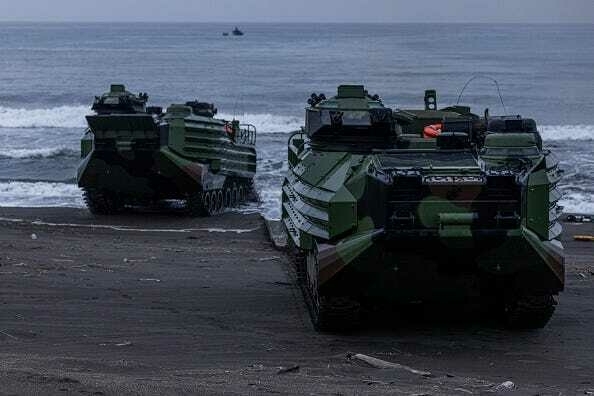
The Taiwanese military conducts amphibious landings to simulate People's Liberation Army (PLA) forces landing on three beaches in Yilan County. These beaches are identified by experts as "red beaches" which are vulnerable to a potential invasion by China. (Photo by Annabelle Chih/Getty Images). Li Ming Zhong has been interested in Taiwanese nature since he was a little boy, when he ran next to the Tamsui River in Taipei and into a nearby forest, where he would sit for hours to observe the natural world.
His passion for nature inspired him to take several solo trips to remote landscapes, eventually leading him to become a high school geography teacher in Taipei.
Ming Zhong, 43, who goes by Willie in school to make it easier for his students to remember his name, has been a teacher for 21 years.
Yet, never did he think he would one day be analyzing Taiwan’s landscape for potential military landing sites as a Chinese invasion over the island looms.
“A ‘red beach’ is a place that is easy for [military landing craft] to land, and harder for [Taiwan] to defend,” Ming Zhong told The Counteroffensive.
Taiwan’s rugged terrain limits the number of viable locations for a Chinese military landing in the event of an invasion. However, there are between a dozen and 20 designated ‘red beaches’ across the island that are considered suitable for such operations.
Over the past decade, Taiwan’s defense ministry has been actively preparing its forces, conducting regular military drills to ensure they can respond swiftly and defend against potential simultaneous attacks by the Chinese military.
We were allowed to tag along for some of these drills.
Military personnel participate an amphibious landing drill on May 24, 2023 in Yilan, Taiwan. (Photo by Annabelle Chih/Getty Images). Red beaches are characterized by being sandy beaches as opposed to ones with many rocks, Ming Zhong said, which makes it easier for the Chinese army to land on.
Most of these can be found on the West Coast, which is closer to mainland China, thereby reducing the time during which Chinese troops would be vulnerable during the passage across the Taiwan Strait.
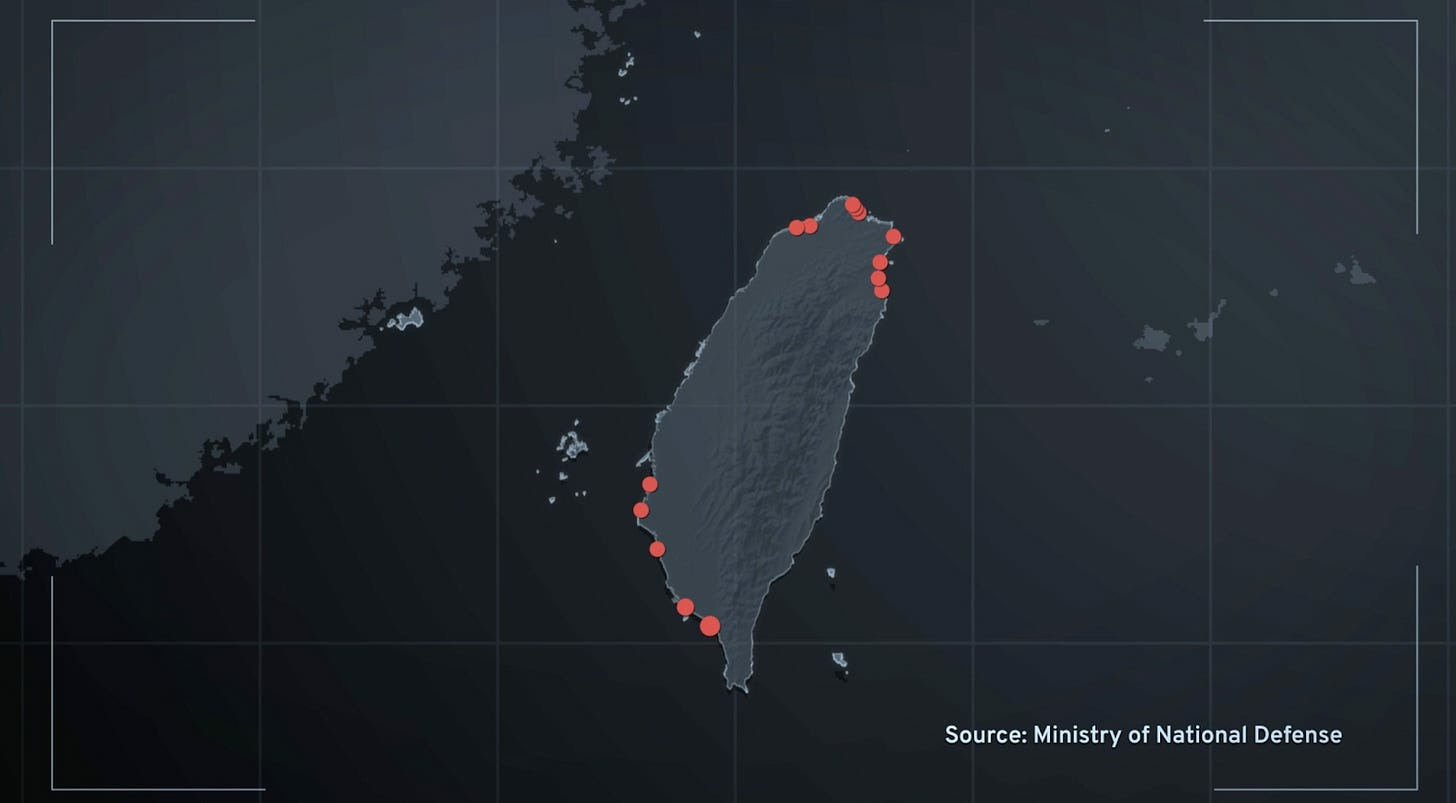
Some of Taiwan’s ‘Red Beaches,’ as identified by its government. Source: Ministry of National Defense via Taiwan Plus News. What many are not aware of, Ming Zhong said, is that Taiwan has natural defenses that will help the island in the wake of an invasion.
The fact that the Taiwan Strait divides the island from the People’s Republic of China (PRC) is an advantage because it gives Taipei time to respond, according to Ming Zhong. The Taiwan Strait is approximately 160 km wide at its narrowest point, and each crossing by a Chinese landing craft would take several hours.
The tide is also a natural advantage of the island, Ming Zhong said. The low tide around the West Coast city of Taichung prohibits big enemy ships from accessing the island, he added.
In addition, the capital city of Taipei is surrounded by mountains, which means that military tanks landing on the red beaches would have to cross them to reach the capital.
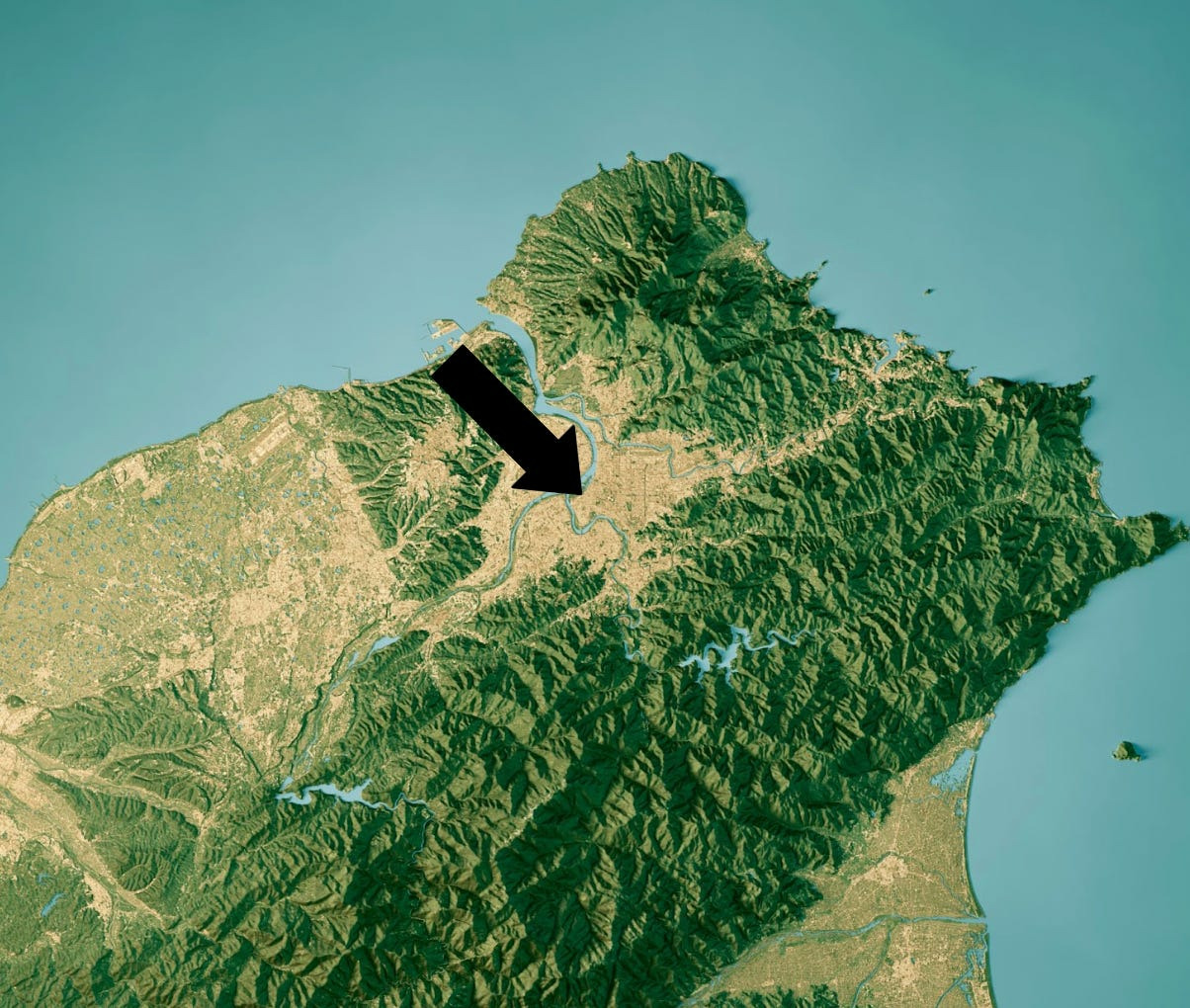
3D Render of a Topographic Map of Taipei City, Taiwan. Arrow points to Taipei. (Photo Credit: Frank Ramspott/ Getty Images). The People’s Liberation Army, the military of the Chinese Communist Party, has been ramping up military pressure over Taiwan since 2016, when the Democratic Progressive Party returned to office in Taipei and refused to endorse Beijing’s ‘One China’ framework. Despite never having governed Taiwan, the PRC views the island as a breakaway province, with China’s President Xi Jinping stating that reunification between Taipei and Beijing is inevitable.
Living in Taiwan, and facing the CCP’s constant threat, Ming Zhong was defiant:
“We should never be afraid of China. History has shown us: Taiwan has been easy to protect and hard to attack… but we need to be aware of the danger, and train ourselves to be ready when bad things happen.”
Amidst a possible Chinese invasion, Taiwan has been intensifying its defense strategy over the past years. Taiwan's President Lai Ching-te announced a civil mobilization plan last year to recruit approximately 400,000 people, including active and former military personnel, as well as volunteers from the police and fire departments.
The Counteroffensive was able to observe a number of military exercises by the Taiwanese Air Force, Navy, Army, and Marines.

A protester in Taipei reminds the Taiwanese public of Russia’s invasion, raising money for the defense of Ukraine. The war in Ukraine has opened the eyes of people in Taiwan on the importance of asymmetric warfare, Wu Tzu-li, an associate research fellow with Taiwan's military think tank, the Institute for National Defense and Security Research, told The Counteroffensive.
Asymmetric warfare is a conflict characterized by a significant disparity in military capabilities and resources between the two sides, and where the weaker side uses unconventional methods to defeat its opponent.
The PRC’s military, which has about 2 million recruits, far surpasses Taiwan’s 215,000 force.
Ukraine has managed to stand out on the battlefield amid its use of drones, Wu said, which has inspired the Taiwanese government to assemble its local production of UAVs and to integrate them into its military strategy.
Before Russia’s invasion of Ukraine, Taiwan’s drone inventory was small, with only a few hundred units of four types of drones. Yet, in 2022, Taiwan’s government launched the ‘Drone National Team’ program to recruit the country’s commercial drone makers and aviation firms to create a self-sufficient drone industry.
Did you know we have a sister publication that covers defense technology right from the battlefield? Here’s our latest piece on Taiwanese military technology and what they’re learning from the war in Ukraine.
Shortly after Russia invaded Ukraine, Lieutenant Colonel Liu Yongcheng, of the 23rd Fighter Squadron, has been monitoring the situation in Ukraine and assessing the need for Taiwan to rapidly deploy its air assets.
At the moment, he does not think it is possible to replace manned aircraft, such as the F-16 fighter jets, with drones, he told The Counteroffensive. Yet, he sees drones playing a significant role in the future, especially when combined with large airframes.
Javelin anti-tank missiles have also helped Ukraine push Russian forces out of Kyiv in the early days of the invasion.
Sergeant Wang Zhi Han of the 9th Marine Corps in Taiwan told The Counteroffensive that they have been familiarizing themselves with Javelin missiles to target enemy vehicles in the event of an attack.
Taiwanese Marines drill on the use of Javelin anti-tank missiles.
Ukraine and Taiwan share many similarities in their fight against two superpowers that are trying to conquer them, Francois Wu, the Taiwanese Deputy Minister of Foreign Affairs, told The Counteroffensive.
But “the economic power of Taiwan is much more important than Ukraine,” he added, because Taiwan has the know-how of semiconductors, which is kind of indispensable for the modern world.”
Taiwan’s semiconductor industry has been acting as a ‘silicon shield’ for the island. The term refers to Taiwan’s ability to deter China’s threat: China might not want to invade Taiwan and disrupt the worldwide trade in semiconductors, which is critical for modern electronics.
Taiwan currently dominates the global semiconductor market, accounting for 68 percent of the world's semiconductor manufacturing, and the industry contributes nearly 15 percent of the island’s gross domestic product.
The PRC has invested billions in efforts to match Taiwan’s production and has set targets of achieving 40 percent self-sufficiency in chips by 2020 and 70 percent by 2025. Yet, it reportedly produces 16 percent of its needs and still imports over $400 billion worth of semiconductors.
While some believe this could be a motive for the PRC to invade Taiwan and maintain control of its semiconductor foundries, Beijing would be unable to achieve its goals if war left the infrastructure destroyed.
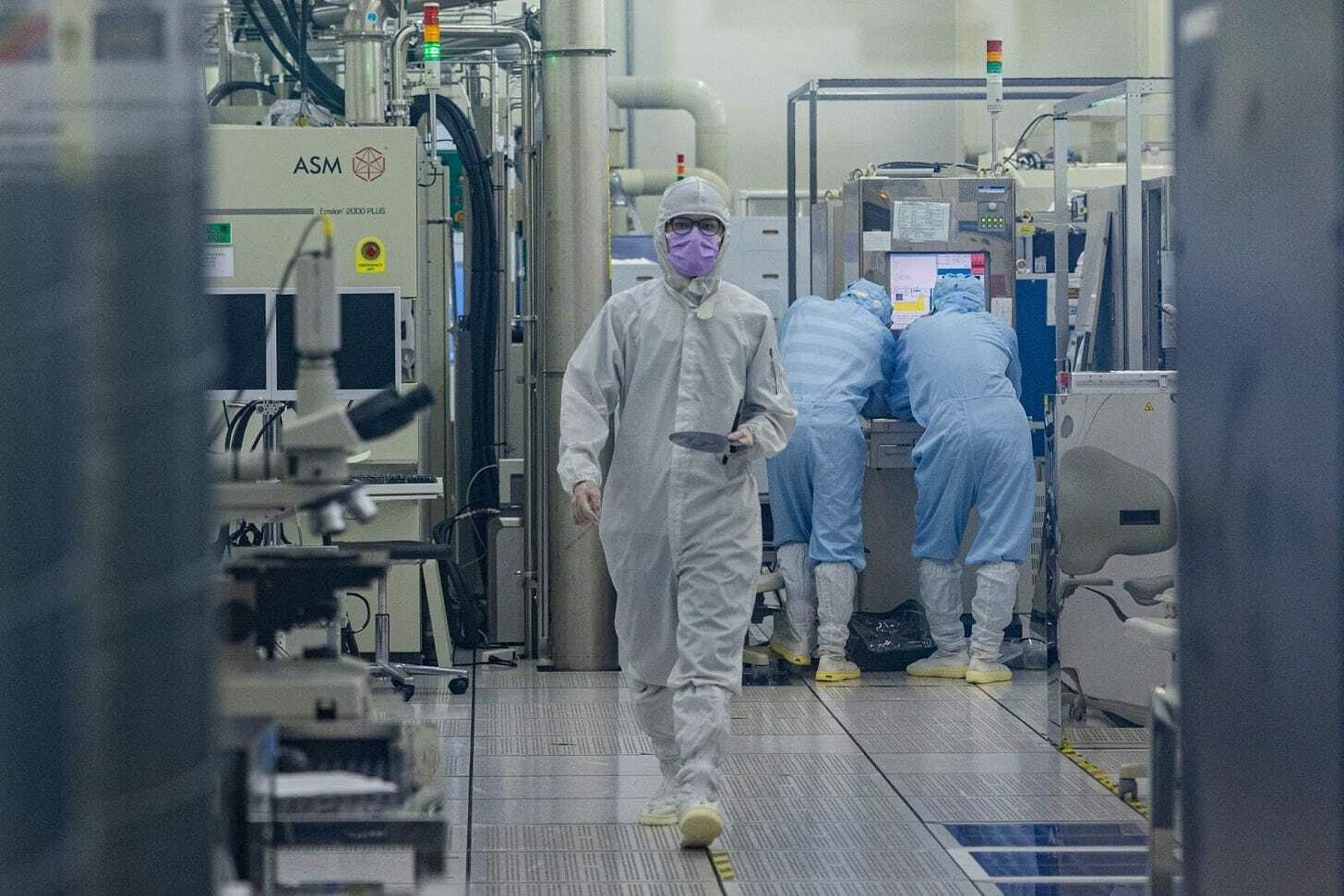
A student wears cleanroom suit conducts a research inside the clean room of Taiwan Semiconductor Research Institution during a press semiconductor tour at Hsinchu Science Park on September 16, 2022 in Hsinchu, Taiwan. (Photo Credit: Annabelle Chih/ Getty Images). “The problem is that now this know-how is not a simple factory,” Zhizhong said. “The semiconductor industry is an ecosystem,” and the result comes from a combination of “all the major democratic countries in the world,” he added.
In recent years, the PRC has intensified its military exercises in the Taiwan Strait, simulating land strikes, sea assaults, and blockades, further heightening tensions between Beijing and Taipei.
In April this year, the Chinese military launched strikes in the East China Sea and simulated blockades close to key shipping lanes near Taiwan. The PRC spent about 7 percent of its defense budget — about $15 billion — on exercises in the Western Pacific in 2023.
Some experts interpret the Chinese drills as rehearsals for a potential blockade aimed at toppling the government in Taipei.
It is easy to quarantine the island, according to Ming Zhong, the high school geography teacher. Yet, the Chinese military “is not used to fighting in the water,” so they will struggle to remain in position for long if they are unable to act fast, he added.
In addition, amid the stream in the Taiwan Strait, one of the island’s biggest natural defenses, the summer months are the hardest to cross as the boats would be going against the direction of the stream, which would require more power, Ming Zhong said.
The winter months, December until March, are easier due to the stream, he added.
The Chinese would also have to take into account Taiwan’s rainy season, which runs from May to June, and typhoon months, which span from July until October.
The easiest months for Beijing to invade would be April and November, according to Ming Zhong.
There are already drones on some of Taiwan’s red beaches. But they are for civilian purposes: fishermen use them to carry their lines deep out into the strait, for a better chance of catching their harvest.
Xing Li, a retired civil engineer who fishes in his spare time, told The Counteroffensive at Zhuwei Beach that he thinks the space was designated a red beach amid its calm and flat waters, particularly from May to August.
Other designated red beaches in Taiwan include Linkou, Jinshan, Zhuangwei, Luodong, Fulong, and Linyuan.
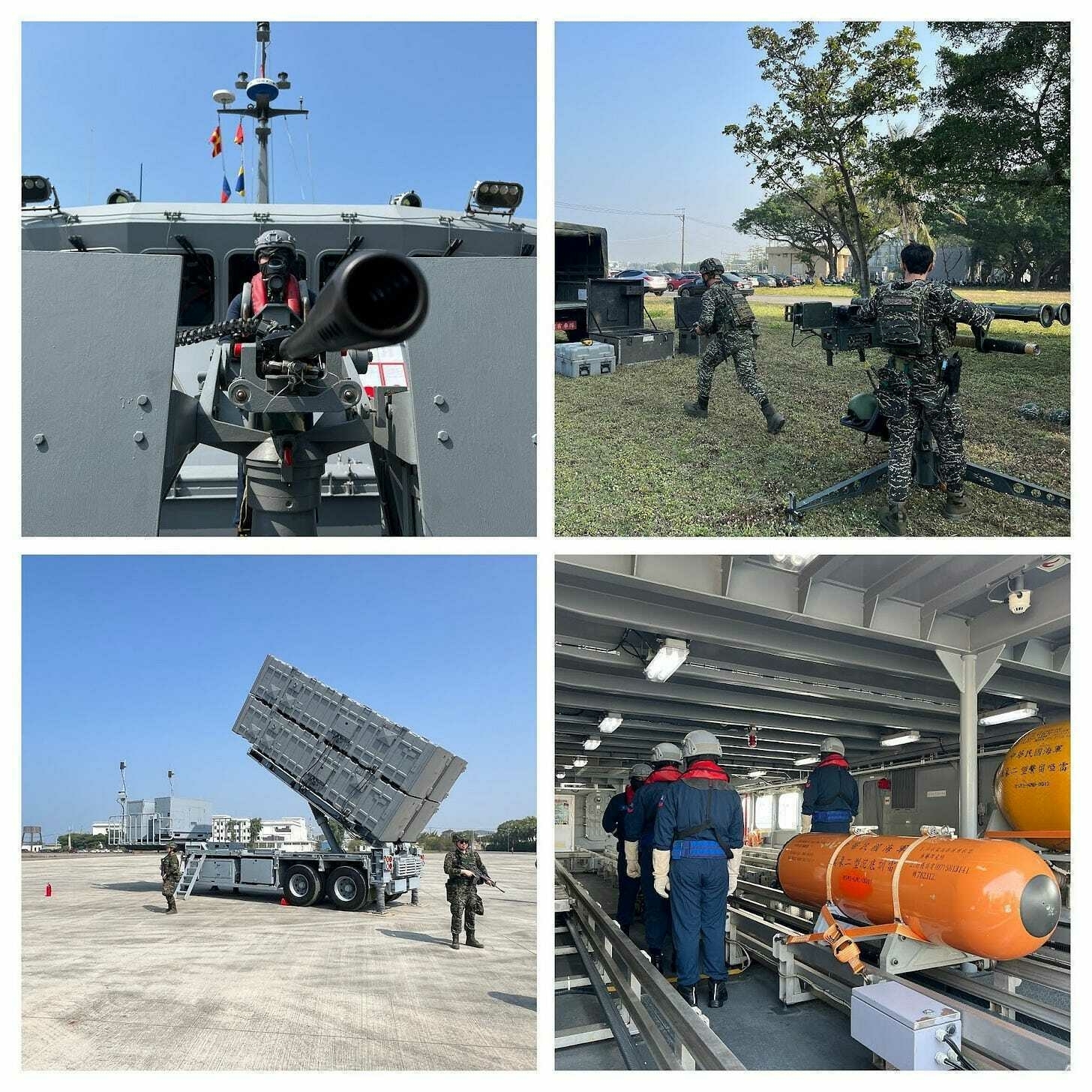
Taiwanese Navy, Army and Marine Corps engage in military exercises as The Counteroffensive looks on. Clockwise from top left: a sailor stands ready at a machine gun; marines perform exercises; troops practice an air defense drill; and sailors prepare to launch a naval mine. Lieutenant Commander Lian Shaopu, head of an eight-boat squadron, is training his people to deploy sea mines to locations that the enemy could use to reach the island.
The goal is to slow down and disrupt a hypothetical Chinese offensive. Every week, their crews get together to understand the type of mines they are working with, he told The Counteroffensive.
The Air Defense Battalion has also included twin-mounted Stinger missiles, also known as the Dual Mount Stinger, into their training.
Marine Staff Sergeant Bao Wei Zhong, who has been in the military for 10 years, told The Counteroffensive that these weapons can fire two missiles simultaneously, enhancing air defense capabilities against targets such as helicopters.
A Taiwanese fighter jet pilot prepares to board his plane.The Taiwanese public would be willing to defend the nation amid a Chinese attack, but the majority believe Beijing will not invade the island within the next five years, a poll conducted by Taipei think tank, the Institute for National Defense and Security Research, revealed.
However, Ming Zhong thinks the stakes are high. “As long as China remains undemocratic, they will always try to invade us. It’s only a matter of time.”
Approximately 68 percent would be willing to defend Taiwan. In addition, 64 percent said China’s “territorial ambition” poses a “serious threat” to the island. Yet, 61 percent said it was unlikely that the People’s Liberation Army would invade in the next five years.
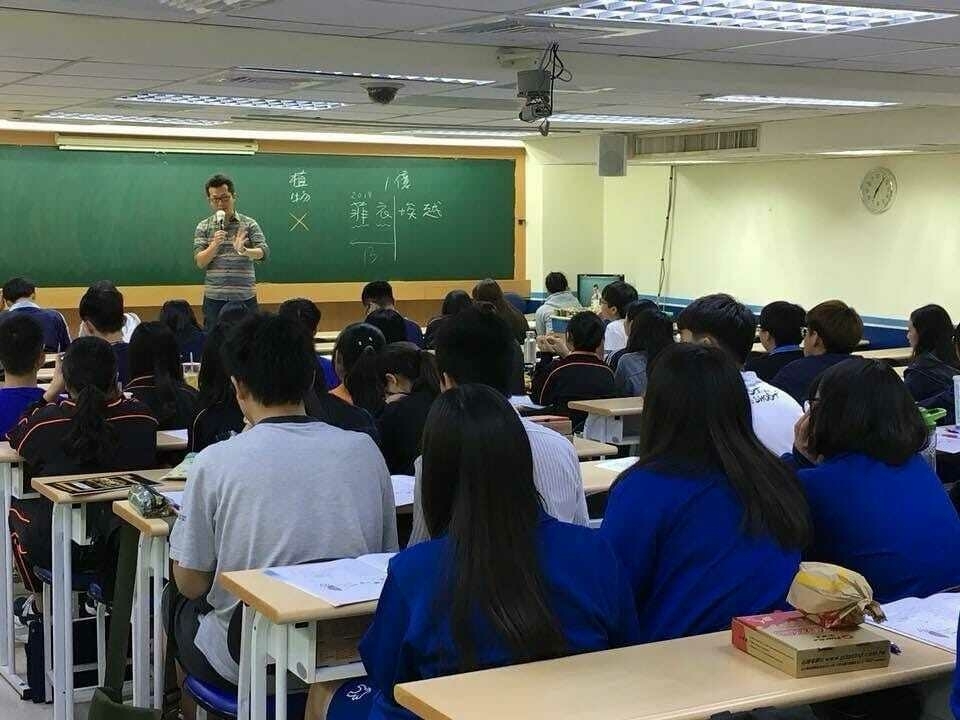
Ming Zhong, who has devoted his life to education and helped Taiwanese kids, teaches geography in his class. For Ming Zhong, a Chinese invasion feels inevitable. As a communist state that restricts individual freedoms, the Chinese Communist Party sees democratic Taiwan as a threat, as its very existence could inspire Chinese citizens to imagine life in a free society.
In the meantime, Ming Zhong continues to share his expertise with his students, teaching them about Taiwan’s natural defenses.
Ming Zhong has been devoted to helping the next generation in Taiwan. One of the things he teaches his students is that they should never run away from their problems.
If the war comes, Ming Zhong will do everything to protect his motherland.
“We need to fight a war that wins the respect from the world. We need the world to understand us and stand for our country, even if the cost is high,” said Ming Zhong.
NEWS OF THE DAY:
Good morning to readers; Kyiv remains in Ukrainian hands.
TAIWAN TESTS NEW WEAPON INSPIRED BY UKRAINE: Taiwan has begun testing a new weapon that could bolster its defenses against a potential Chinese invasion: sea drones.
Inspired by Ukraine’s successful deployment of sea drones in the Black Sea, Taiwan is exploring this low-cost, high-impact technology to strengthen its maritime security. The remotely operated drones can carry explosives and are capable of targeting both ships and aerial threats.
“Uncrewed boats or vehicles have played a very significant role in the Ukraine war,” Chen Kuan-ting, a lawmaker from Taiwan’s ruling Democratic Progressive Party, told Reuters.
CONGRESS URGED TO RESUME SEARCH FOR DEPORTED KIDS: 30 members of Congress from both parties issued a letter to Secretary of State Marco Rubio, urging him to maintain funding for the Conflict Observatory at Yale University’s Humanitarian Research Lab, which helps locate Ukrainian deported children.
Elon Musk’s Department of Government Efficiency (DOGE) shut down the program at the end of January. After being forcibly shut down, Yale researchers lost access to a database of 35,000 children they had compiled over three years. Although the database was eventually handed over to Europol, the EU’s law enforcement agency, lawmakers have warned that the data could become outdated within weeks.
Nathaniel Raymond, the head of Yale’s researchers, told The Counteroffensive earlier that without HRL's work, Ukraine will lose access to four crucial capabilities:
Whereabouts of children that have been taken for re-education, adoption, military training, or similar purposes;
Names/files of children who have been made Russian citizens;
Number of children believed to have been sent to Russia for re-education; and
Forensic analysis of documents detailing how Russia makes these children citizens.
Moreover, according to the lawmakers’ letter, few organizations possess the same level of expertise in open-source investigations, collecting photos and videos of deported children, and working with Russian websites.
RUSSIAN OIL PRICES SURGE AFTER ISRAEL-IRAN STRIKES. Russian oil prices surged after Israel’s attacks on Iran raised fears of global supply disruptions, marking the largest intraday gain since the day after Russia’s full-scale invasion of Ukraine in 2022.
Until Friday, Moscow’s oil revenues had been falling, with prices slumping below the $60-per-barrel price cap. But the renewed volatility sparked a rally on Russia’s stock exchange, with domestic oil and gold companies posting significant gains.
U.S. OPPOSES LOWERING RUSSIAN OIL PRICE CAP. The United States is resisting efforts to lower the G7 price cap on Russian oil, despite mounting pressure from European allies.
Ahead of the G7 summit, Bloomberg reports that sources familiar with the matter say the Trump administration opposes reducing the cap from $60 to $45 per barrel.
The cap, introduced in December 2022, was designed to curb Moscow’s oil revenues and weaken its ability to fund the war. It bars Western firms from purchasing Russian crude above $60 per barrel.
Despite U.S. resistance, other G7 members are reportedly prepared to move forward with the proposal without Washington’s backing.
DOG OF (PREPARING FOR) WAR:
A stray dog runs across military parade grounds before a Taiwanese Army drill. It did not stop to tell us his name!
Stay safe out there.Best,
Tim -
Trump gave Putin a ‘two-week’ deadline to consider peace in Ukraine. Instead, Russia just launched more drones.
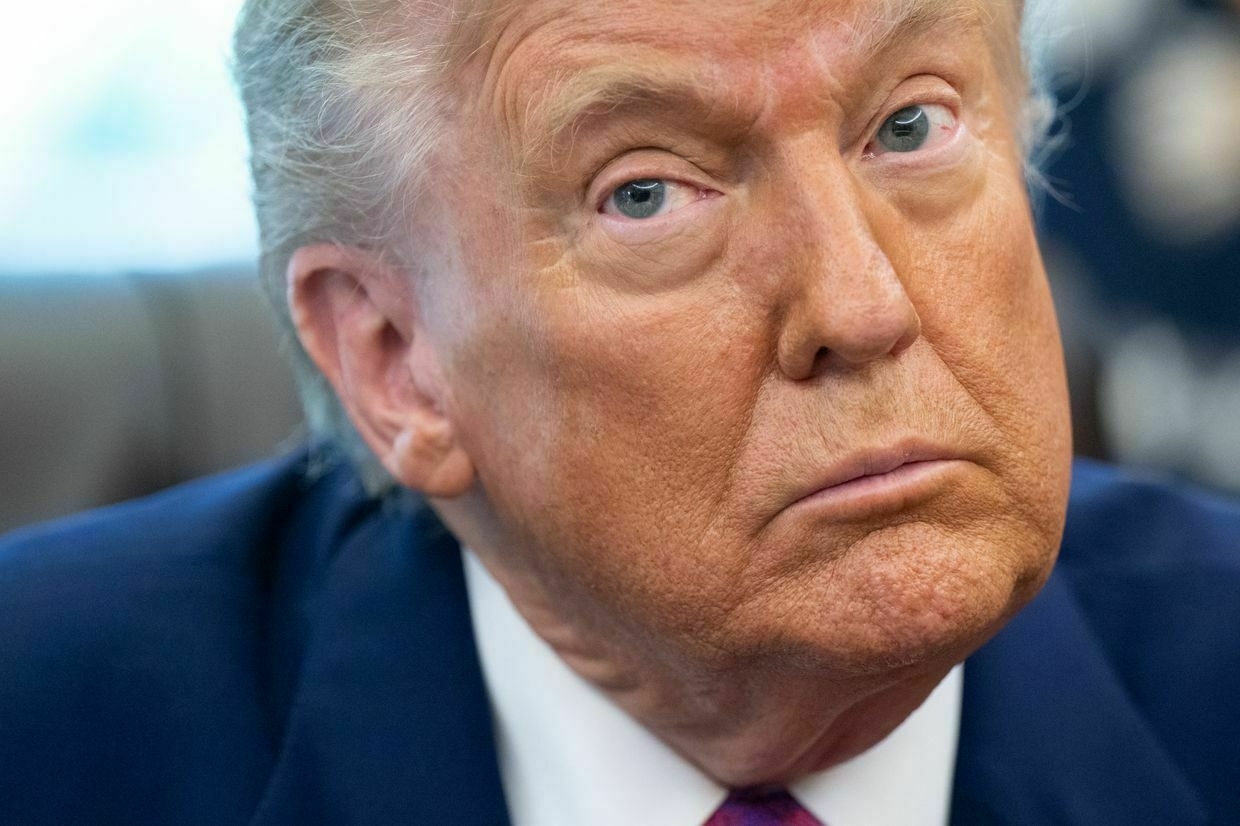
A “two week” deadline imposed by U.S. President Donald Trump to see if Russia is serious about peace in Ukraine has been and gone, with Moscow’s escalation of attacks on civilians during this period failing to draw the slightest condemnation from the White House.
“We’re going to find out very soon. It’ll take about two weeks, or a week and a half,” Trump told reporters on May 28, responding to a question on whether Russian President Vladimir Putin wants to end the war.
His comments came two days after Russia carried out the biggest drone attack of the full-scale war, which reportedly involved 355 Shahed-type attack drones and decoys.
Since the deadline was imposed, this record has been broken twice — Russia attacked Ukraine overnight on June 1 with 472 Shahed-type attack drones, and on June 9, 479 drones and 20 missiles were launched against Ukrainian cities.
The figures are stark. In March 2025, Russia launched 4,198 drones at Ukraine, which is so far the largest monthly number of drones launched during the full-scale invasion.
But if the intensity of attacks so far in June continues, that figure could reach nearly 7,000.
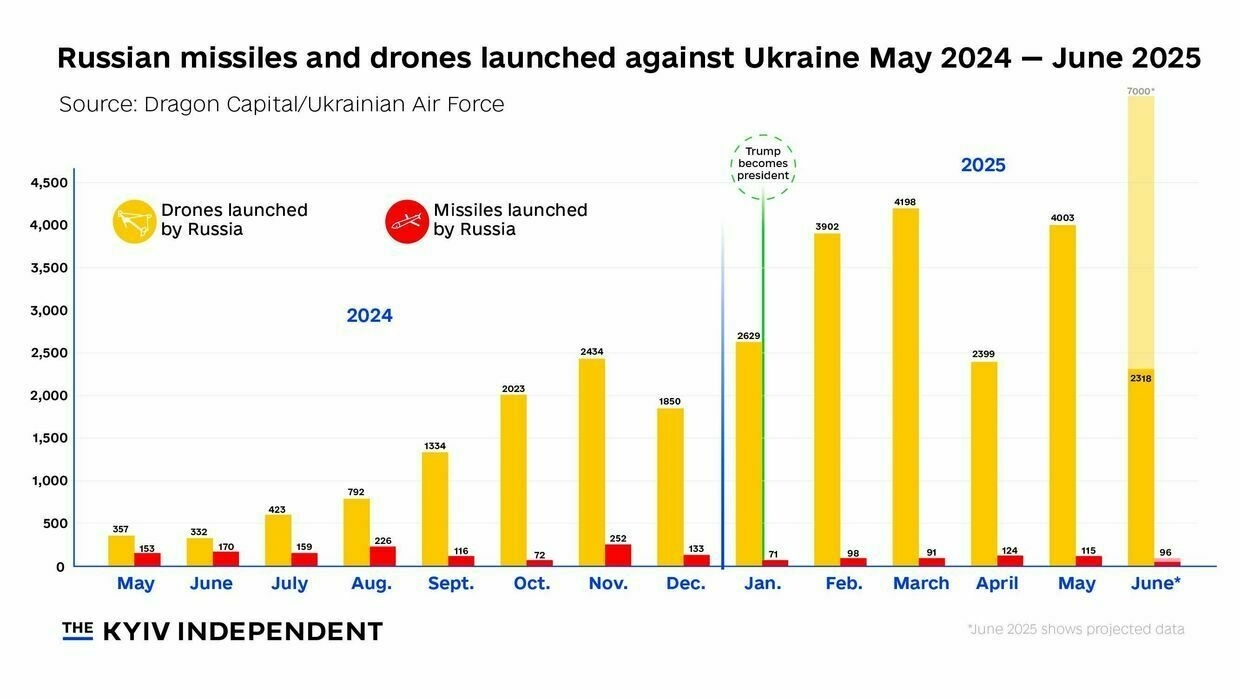
Russian missiles and drones launched against Ukraine May 2024-June 2025. (Nizar al-Rifai/The Kyiv Independent) “This is terrorism against the civilian population aimed to create a sense of doom, war-weariness, and to put pressure on the (Ukrainian) authorities,” Rodion Rozhkovskiy, co-founder of Liveuamap, told the Kyiv Independent.
Despite previously hinting at the imposition of new sanctions against Russia if the Kremlin doesn’t show a desire to end the war, Trump has so far taken no action against the ongoing escalation of violence by Moscow’s forces.
“Lately, every attack instills a huge fear that does not disappear until the air alarm is over.”
Instead, Trump on June 6 excused Russia's escalating attacks, saying Ukraine's Operation Spiderweb, an attack on Russian bomber aircraft, "gave Putin a reason to go in and bomb the hell out of them."
Operation Spiderweb was a clinical strike against legitimate military targets. Russia's drone strikes indiscriminately target civilians, illegal under international law.
On June 12, for the first time since the launch of the full-scale invasion, U.S. Secretary of State Marco Rubio released a statement to mark Russia Day.
"On behalf of the American people, I want to congratulate the Russian people on Russia Day," Rubio said.
"The United States remains committed to supporting the Russian people as they continue to build on their aspirations for a brighter future."
Meanwhile in Ukraine, a brighter future for those living in cities under near-nightly bombardment by the Russian people seems far out of reach.
"Lately, every attack instills a huge fear that does not disappear until the air alarm is over," Kyiv resident Oleksandra Pshenychna, 20, told the Kyiv Independent.
"The worst feeling that comes is despair accompanied by a sense of emptiness, inevitability, and hatred for those people who are behind the launch of Russian drones and missiles into residential buildings, cultural monuments, and crowds of people," she added.

Ukrainian civilians injured in Russian attacks May 2024-May 2025. (Nizar al-Rifai/The Kyiv Independent) 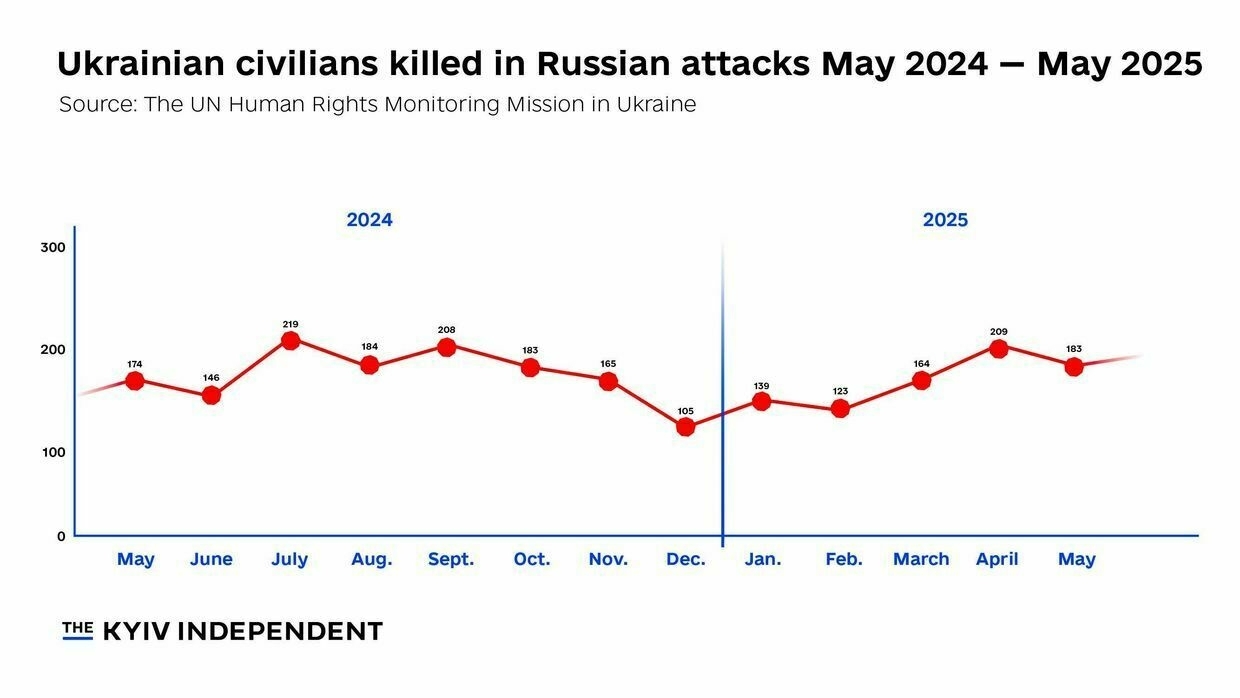
Ukrainian civilians killed in Russian attacks May 2024-May 2025. (Nizar al-Rifai/The Kyiv Independent) Russia's disregard for Trump's statements and threats long predates his two week deadline — data on Russian drone strikes clearly indicate that despite the U.S.-led peace process initiated after Trump took office, Moscow has launched larger drone attacks on civilians than it did during the presidency of Joe Biden.
This is despite Trump's multiple promises to end the war in 24 hours, which then turned into 100 days. Trump has now been in office for 144 days.
His search for a peace deal has seen a flurry of diplomatic meetings around the globe, severe and sustained pressure on Ukraine, and a reluctance to force any concessions from Russia.
During this time, Russia has continued to attack Ukraine on a daily basis. Ahead of the second round of direct peace talks held in Istanbul on June 2, Russia killed 9 civilians and injured 49 others.
"They [russians] are using all they can use — if they could use more, they would use more."
Kharkiv resident Mykola Zhydkov told the Kyiv Independent that he has noticed that particularly heavy bombardments often actually coincide with peace process-related events that the White House portrays as positive steps towards a potential ceasefire.
"On June 10, POWs were swapped. On the same night, Kharkiv suffered a major attack," Zhydkov said.
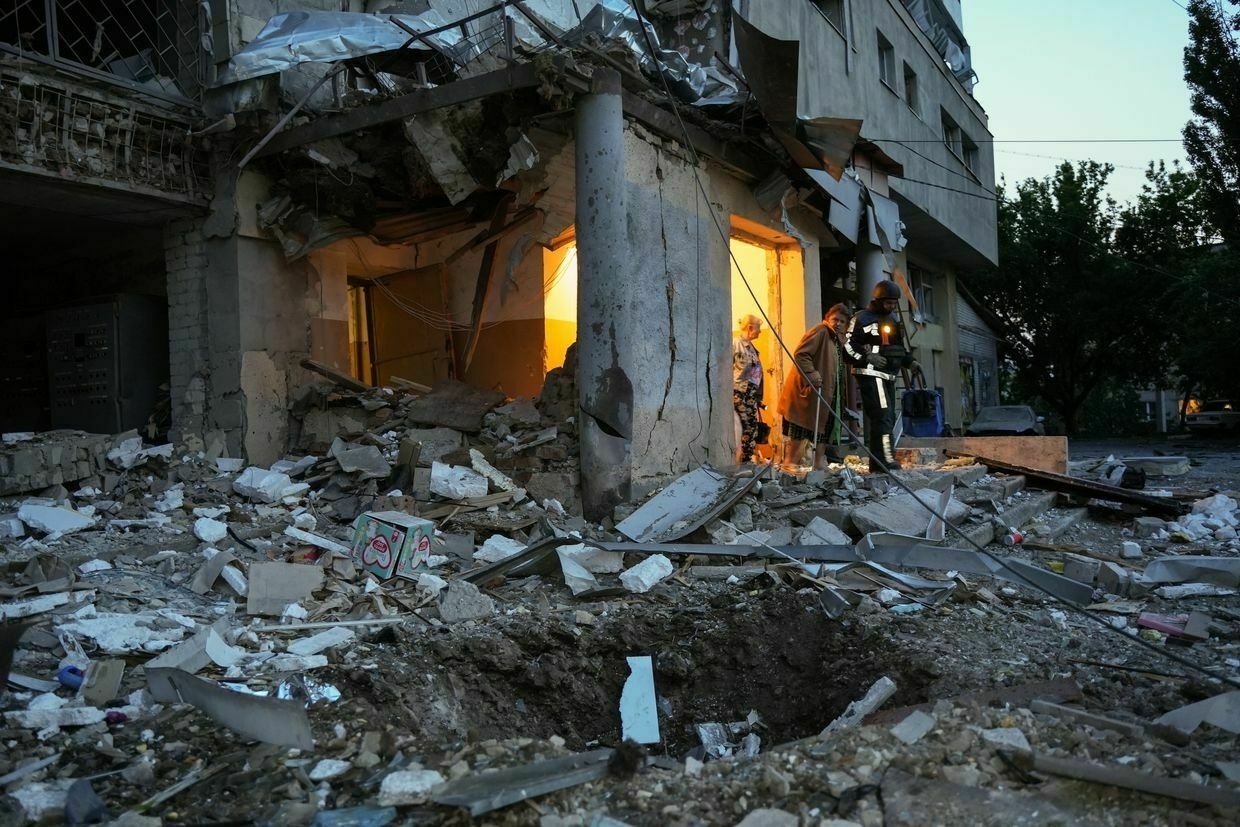
An elderly woman walks with the help of a rescuer amid rubble from a damaged residential building after a Russian drone attack in Kharkiv, Ukraine, on June 12, 2025. (Viacheslav Mavrychev / Suspilne Ukraine / Global Images Ukraine via Getty Images) With Trump so far failing to respond to Russia's escalating drone strikes, the Kremlin has little incentive to stop. All signs point to Moscow's defense industry only increasing its ability to launch ever-larger mass attacks.
According to Rozhkovskiy, the only limiting factor in how many drones Russian can launch in any given attack is how many its factories can produce.
"They are using all they can use — if they could use more, they would use more," he said.
The Russian production surge is being facilitated by imports of components from China and the recruitment of low-skilled labor from foreign countries, including from those in Africa.
Russia is also building new launch sites and will soon be able to deploy more than 500 long-range drones a night to attack Ukraine, a source in Ukraine's military intelligence (HUR) told the Kyiv Independent last week.
Israel-Iran war could provide economic boost Russia needs to continue fight against UkraineIsrael’s “preemptive” strikes against Iran targeting the country’s nuclear program and killing top military officials could have far-reaching implications for Ukraine and could boost Russia’s ability to continue its full-scale invasion, experts have told the Kyiv Independent. Iran has been one of Russia’s staunchest allies throughout the war, providing thousandsThe Kyiv IndependentChris York
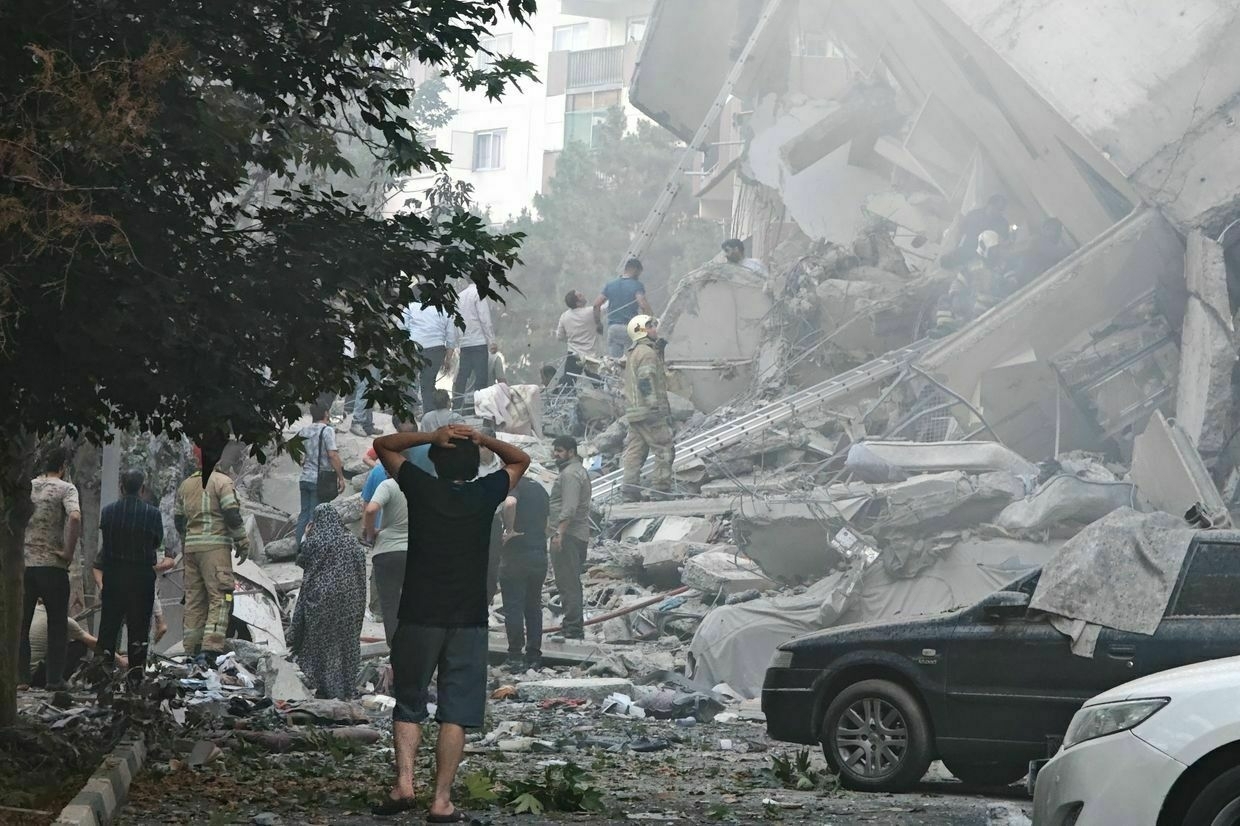
-
Ukraine, Russia conduct fourth prisoner exchange this week

Kyiv is continuing efforts to bring home its citizens held captive by Russia, marking the fourth prisoner exchange in a week, President Volodymyr Zelensky announced on June 14.
“Today, among those returning to Ukraine, many have been in captivity since 2022,” Zelensky said. “These include soldiers from the Armed Forces, National Guard, State Border Guard Service, and the State Special Transport Service."
The exchanges are part of the agreement reached during talks held in Istanbul earlier this month, where both sides agreed to phased prisoner swaps and repatriation of fallen soldiers.
-
Ukraine repatriates bodies of 1,200 citizens in latest swap with Russia

Editor’s note: This is a developing story and is being updated.
Ukraine has recovered the bodies of 1,200 fallen citizens, including military personnel, in the latest round of repatriation efforts coordinated with Russia under agreements reached during talks in Istanbul, Ukrainian officials said on June 14.
The Coordination Headquarters for Prisoners of War said the bodies, which Russian authorities claim belong to Ukrainian nationals, were returned as part of an ongoing phased exchange process.
“The remains will now undergo forensic examination and identification procedures conducted by law enforcement investigators in cooperation with expert institutions under the Interior Ministry,” the Coordination Headquarters said in a statement.
Zelensky plans to meet Trump at G7 summit — key takeaways from closed-door briefing“Both teams are working to ensure we meet,” President Volodymyr Zelensky said.The Kyiv IndependentAnna Fratsyvir
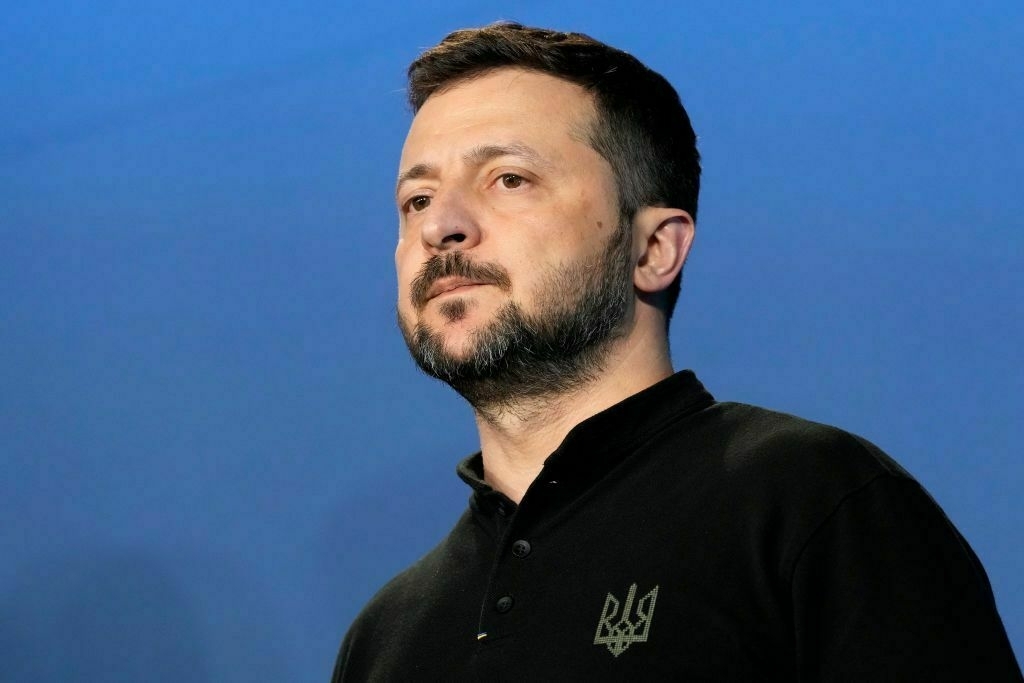
-
Zelensky plans to meet Trump at G7 summit — key takeaways from closed-door briefing
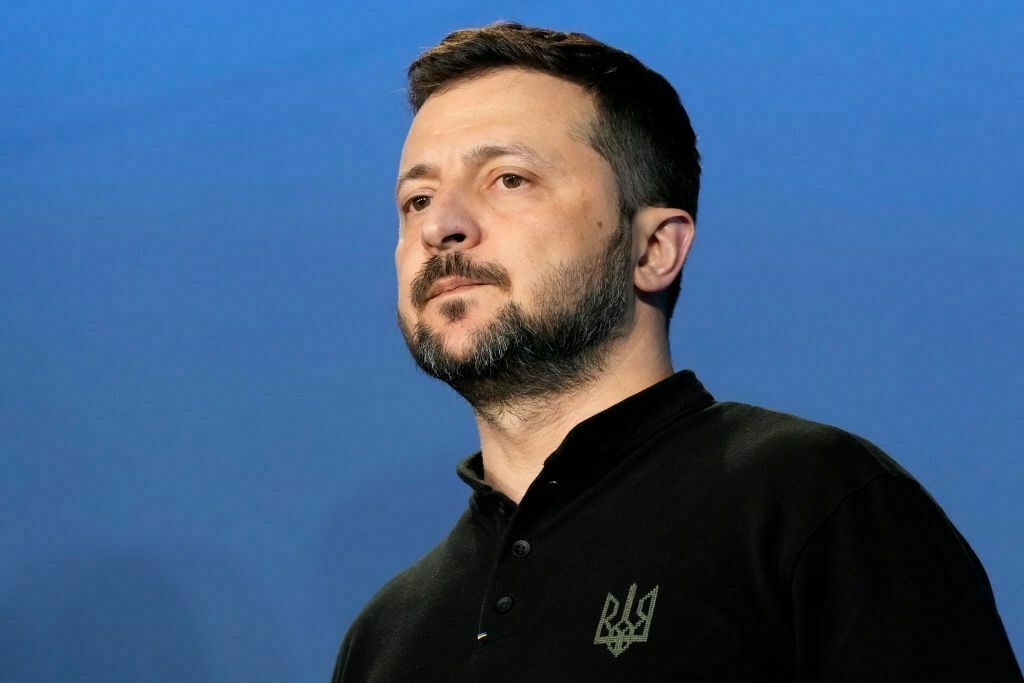
President Volodymyr Zelensky’s office has confirmed plans for a high-stakes meeting with U.S. President Donald Trump at the upcoming G7 summit on June 17, according to the Kyiv Independent journalist who attended a closed-door briefing with Zelensky on June 13.
“Both teams are working to ensure we meet,” Zelensky said.
The meeting would mark the third in-person encounter between the two leaders during Trump’s second term in the White House. Their most recent meeting took place on April 26 at St. Peter’s Basilica in the Vatican, where they spoke privately on the sidelines of Pope Francis' funeral. Both sides described the meeting as productive and constructive, though details remained sparse.
Earlier in February, Zelensky met Trump and Vice President JD Vance in the White House when the infamous tense Oval Office exchange erupted, with Trump criticizing Kyiv’s perceived lack of gratitude for U.S. support
Zelensky said his priority is to discuss with Trump sanctions against Russia, peace talks, weapons purchase, and U.S.-Ukraine economic cooperation.
“The United States communicates with the EU on sanctions at the level of senators and congressmen. But I want to raise this issue personally with President Trump,” Zelensky said.
“There are steps forward we can take — but we need the political will of the U.S. president, if he wants."
He added that Ukraine has long prepared a “strong” weapons package to purchase from Washington. “Only at the presidential level can we finalize it,” Zelensky said ahead of the G7 summit.
Russian offensives in Sumy, Dnipropetrovsk oblastsZelensky said that heavy fighting is ongoing along Ukraine’s northeastern border. Russian forces have concentrated around 53,000 troops in the Sumy sector, pushing into multiple settlements such as Andriivka, Kindrativka, and Oleksiivka.
According to the open-source monitoring group DeepState, Russian troops have been advancing along the border in Sumy Oblast, with the current front line lying just about 20 kilometers away from the regional capital of Sumy.
According to media reports, Russia exploited a thinning of Ukraine’s front-line forces, which were later replaced by newer, under-equipped formations.
Zelensky said that Russia only pushed seven kilometers deep into Sumy, adding that the Russian army “has been stopped there."
Zelensky added that Ukrainian forces had successfully struck Russian positions in the neighboring Russian Kursk Oblast, near Tyotkino, to stall Russian momentum and split their offensive groups.
In Dnipropetrovsk Oblast, Zelensky confirmed that small Russian reconnaissance groups had briefly crossed into Ukrainian territory — likely for propaganda purposes. One six-man unit was reportedly eliminated one kilometer from the administrative border.
“For them (Russia), it’s an important story, to take a photo, video,” Zelensky said. “That’s why they are launching small working groups to do just that."
Earlier, the Kremlin has claimed the operations in Dnipropetrovsk are part of an effort to create a so-called “buffer zone.” Ukrainian officials have rejected these claims as disinformation.
As Russian losses in Ukraine hit 1 million, Putin’s war economy heads toward breaking pointRussian losses in Ukraine hit a massive, and grim milestone on June 12 — 1 million Russian soldiers killed or wounded during the 39-month-long full-scale war, according to figures from Kyiv. Although hugely symbolic, the number is unlikely to prompt a change in tactics from Moscow as it gears up forThe Kyiv IndependentChris York

Israel-Iran war hits Ukraine’s defensesWhen speaking about the recent escalation between Israel and Iran in the Middle East, Zelensky said that the subsequent regional tension had driven up oil prices, enhancing Russia’s war financing through energy exports.
“This factor clearly doesn’t help us,” he said, adding that Ukraine will urge Washington to implement stricter price caps on Russian oil at the G7.
He further revealed that U.S. weapons previously allocated to Ukraine, including 20,000 air-defense interceptors used to counter Iranian-designed Shahed drones, were redirected to support Israel ahead of its recent strikes on Iran.
“That was a serious blow… We were counting on these missiles,” Zelensky said.
Zelensky warned that Ukraine must not become “a bargaining chip” in larger geopolitical negotiations involving the U.S., Russia, and the Middle East. Russia and Iran have deepened their cooperation since 2022, with Iran supplying weapons and technology to boost Moscow’s war machine.
“I was constantly afraid that we could become a bargaining chip, just one factor in the negotiations between the United States and the Russians. So, along with the situation with Iran, the situation with Ukraine was also a factor. They are really dependent on each other,” he said.
Join our communitySupport independent journalism in Ukraine. Join us in this fight.Support usEurope's indecisivenessZelensky voiced concerns about a slowdown in Western diplomatic momentum, particularly around the "coalition of the willing" initiative led by France and the UK.
Earlier, media reported that the "coalition of the willing," aimed at offering post-ceasefire security guarantees to Ukraine, has faced delays due to the absence of U.S. commitment.
"Europe hasn't yet decided what to do if America steps back," he said. "Their energy depended on U.S. resolve. Without it, things slow down."
Still, Zelensky made clear that Ukraine would not accept any ultimatums from Moscow amid the uncertainty of Western support. He described the latest Russian ceasefire proposals as capitulation.
"They pretend to be ready for talks, but all they offer is an ultimatum," Zelensky said. "We won't go along with that. Not now, not ever."
Zelesnky also expressed optimism that the European Union's 18th sanctions package would pass later this month and said he would personally push for closer U.S.-EU coordination at the G7.
Israel-Iran war could provide economic boost Russia needs to continue fight against UkraineIsrael’s “preemptive” strikes against Iran targeting the country’s nuclear program and killing top military officials could have far-reaching implications for Ukraine and could boost Russia’s ability to continue its full-scale invasion, experts have told the Kyiv Independent. Iran has been one of Russia’s staunchest allies throughout the war, providing thousandsThe Kyiv IndependentChris York
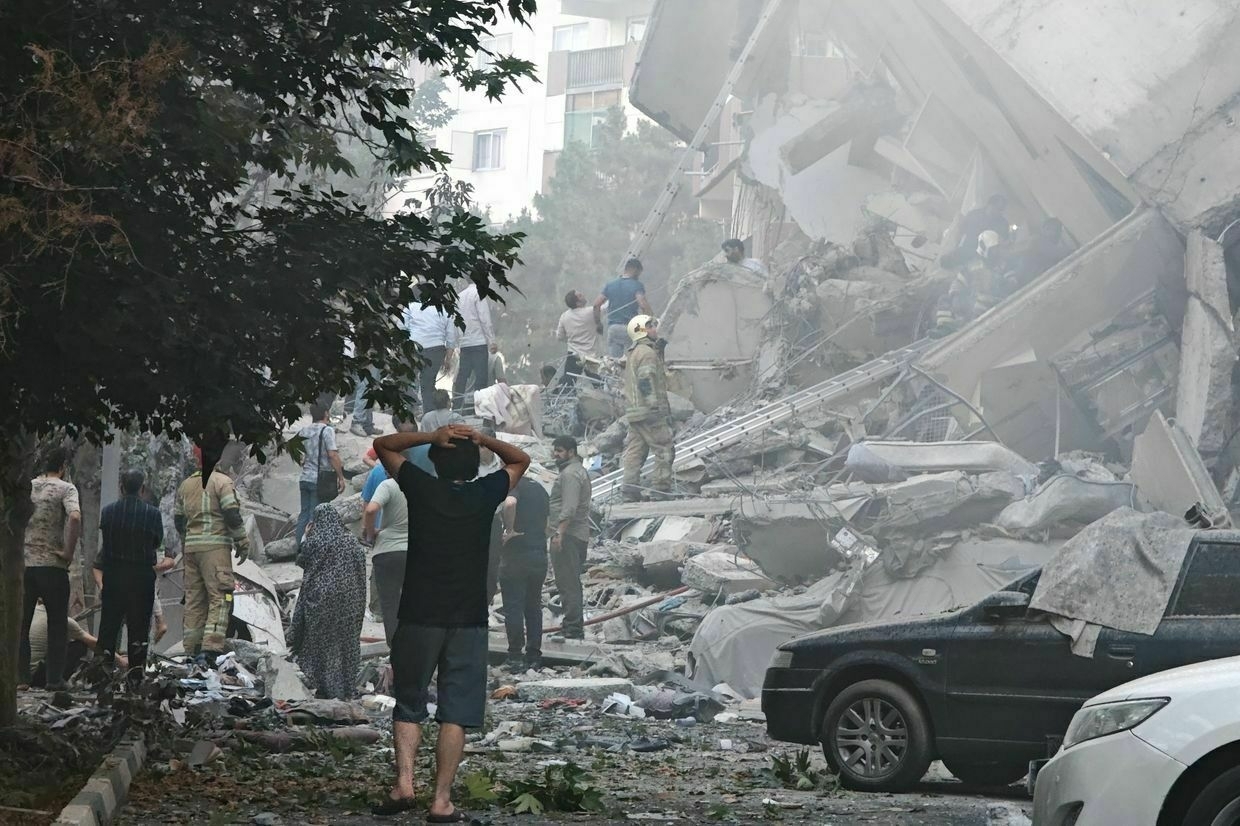
Prisoner exchanges and prospects for talksZelensky confirmed that prisoner exchanges with Russia are continuing and that another round of direct peace talks with Moscow may take place soon after.
"We expect that they (prisoner swaps) can be completed on the 20th or 21st (of June)," he said.
Over the week, Ukraine and Russia held a series of exchanges under an agreement reached during peace talks in Istanbul. Most recently, on June 12, Ukraine brought home another group of severely wounded and seriously ill service members.
The June 12 operation followed a similar swap two days earlier, both conducted without immediate disclosure of the number of released prisoners.
The June exchanges are part of a phased prisoner swap arrangement agreed during the second round of direct talks between Ukrainian and Russian delegations in Istanbul on June 2. While no political breakthroughs emerged from the discussions, both sides agreed to continue exchanging POWs and repatriating the remains of fallen soldiers.
-
Ukraine aims to boost drone intercept capabilities after record Russian attacks
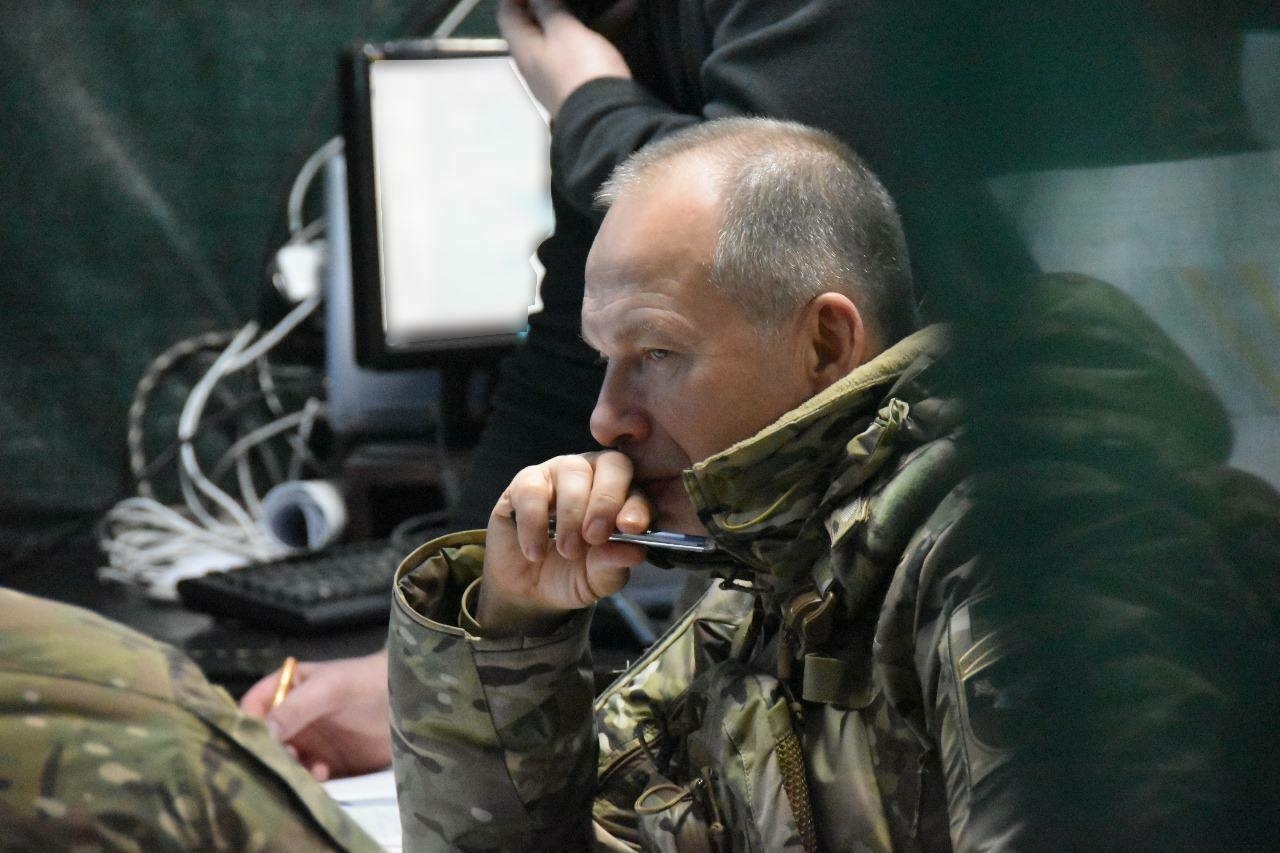
Efforts are underway to rapidly expand Ukraine’s ability to counter Russian drone attacks, Commander-in-Chief of Ukraine’s Armed Forces, Oleksandr Syrskyi, said on June 14.
In a statement shared on Telegram, Syrskyi said he held a meeting focused on strengthening defenses against Russian strike drones, particularly Iranian-designed Shahed drones used by Russian forces to target Ukrainian cities.
“Task number one is scaling up the systems that already work effectively,” Syrskyi said. “First and foremost, that means increasing the number of drone interceptors."
Russia has been escalating drone attacks against Ukraine over the past weeks, launching record 400-500 UAVs (unmanned aerial vehicles) per night.
Syrskyi emphasized the need for a comprehensive approach that incorporates all available capabilities. “(Russia) is constantly modifying the characteristics of its Shaheds and changing their tactics,” he said.
Ukrainian officials discussed ways to improve early detection of incoming drones and ensure their timely destruction. Syrskyi said he had set clear priorities and tasked military leaders accordingly.
Russia has repeatedly targeted Ukrainian cities with waves of attack drones, often striking energy infrastructure and residential buildings overnight. Ukraine’s defense forces use a mix of electronic warfare, air defense systems, and drone-on-drone interception to repel the assaults.
Drones have become one of the defining tools of the full-scale war, used extensively by both Ukraine and Russia for surveillance, long-range strikes, and tactical battlefield advantage. In recent weeks, Russia has intensified its drone and missile attacks on Ukrainian cities and infrastructure.
Earlier on June 9, Ukraine’s Air Force said it intercepted 479 drones and missiles during one of the largest attacks since the start of the war. Russia launched 499 weapons overnight, including 479 Shahed-type drones and multiple ballistic and cruise missiles.
-
Drones reportedly hit major Russian chemical and fuel industry plants overnight
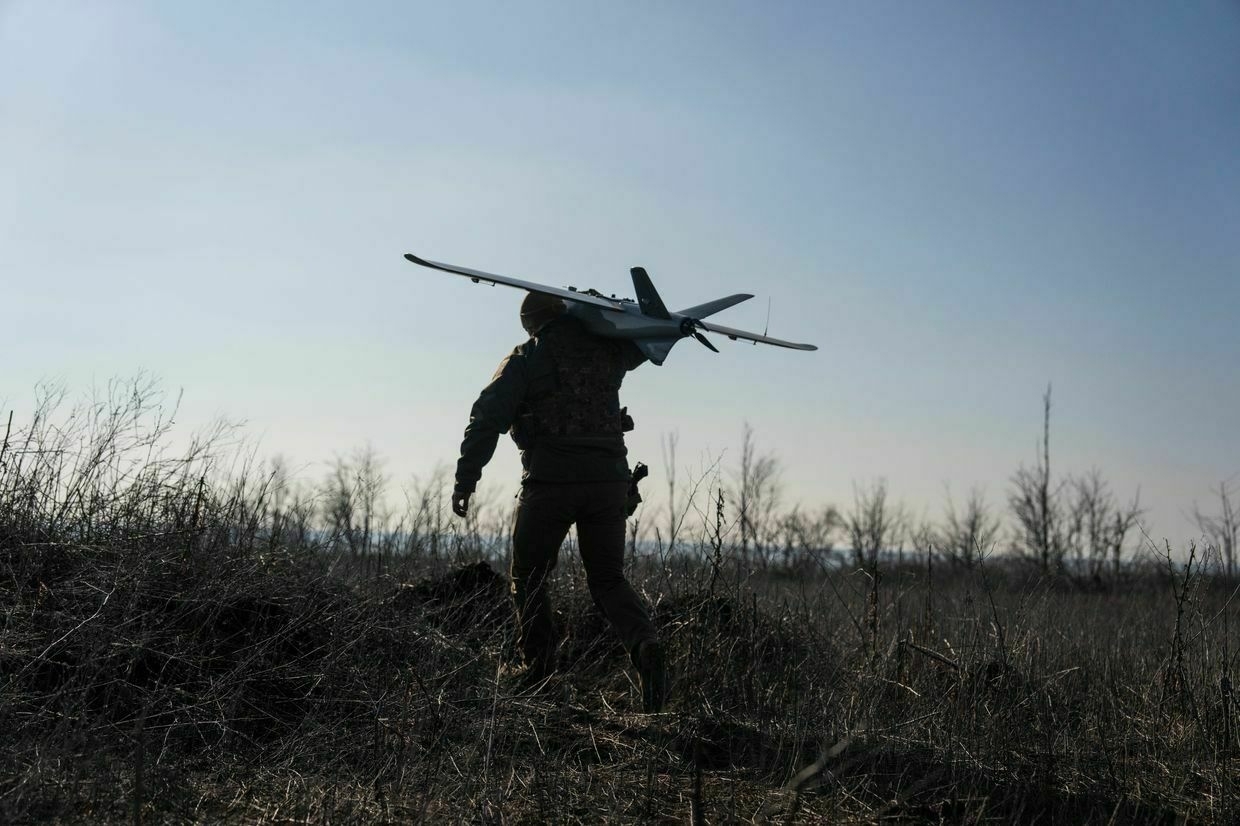
Drones struck two industrial plants in Russia overnight on June 14, targeting one of the country’s largest nitrogen fertilizer producers in Stavropol Krai and a major fuel catalyst facility in Samara Oblast, according to Russian regional officials.
Ukrainian forces regularly launch long-range drone strikes against Russia’s military and industrial targets in the rear, aiming to undermine its ability to wage its all-out war. Ukrainian authorities have not officially commented on the reported attacks.
Stavropol Governor Vladimir Vladimirov said drone debris fell in the city’s industrial zone, confirming the strike was aimed at the Nevinnomyssk Azot plant. He initially reported one person injured, but later clarified there were no casualties. Footage circulating online showed explosions and drones flying over the city.
Nevinnomyssk Azot is among Russia’s top producers of ammonia and nitrogen fertilizers, and hosts the country’s only production lines for methyl acetate and high-purity acetic acid. It also operates Russia’s first melamine production facility, according to open-source data.
The plant, which produces up to one million tons of ammonia and over one million tons of ammonium nitrate annually, is “a critical element of Russia’s military-industrial complex,” Andrii Kovalenko, head of Ukraine’s Center for Countering Disinformation at the National Security and Defense Council, said.
Kovalenko noted that ammonium nitrate is a key component for explosives and artillery shells. He added that the plant also synthesizes dual-use chemicals such as melamine, acetic acid, methanol, and potassium nitrate, frequently used in the production of grenade launchers, mines, and rocket charges.
Since 2024, the plant has been producing water-soluble fertilizers, which he said have been adapted to serve military chemical needs.
In Russia’s Samara Oblast, a separate drone strike reportedly damaged the Novokuybyshevsk Catalyst Plant, the country’s largest specialized facility for producing catalysts used in petroleum refining and petrochemicals. The region’s governor, Vyacheslav Fedorishchev, confirmed an attempted drone attack overnight on an industrial site in Novokuybyshevsk.
Kovalenko said the plant has a strategic role, stating that without its output, Russia’s oil refineries, and by extension, its supply of aviation fuel, diesel for armored vehicles, and rocket propellant, would be severely affected.
Russia’s Defense Ministry claimed it intercepted a total of 66 drones overnight across several regions, including 30 over Voronezh Oblast, 10 over Belgorod Oblast, 8 over Stavropol Krai, 6 over occupied Crimea, 1 over Samara Oblast, and 11 over the Azov Sea.
Russian military equipment reportedly hit in Ukrainian drone attack against CrimeaThe Crimean Wind Telegram channel reported a hit in Simferopol, Crimea’s capital, sharing a photo of a plume of smoke rising in the vicinity of a local power station and of the village of Perevalne.The Kyiv IndependentMartin Fornusek
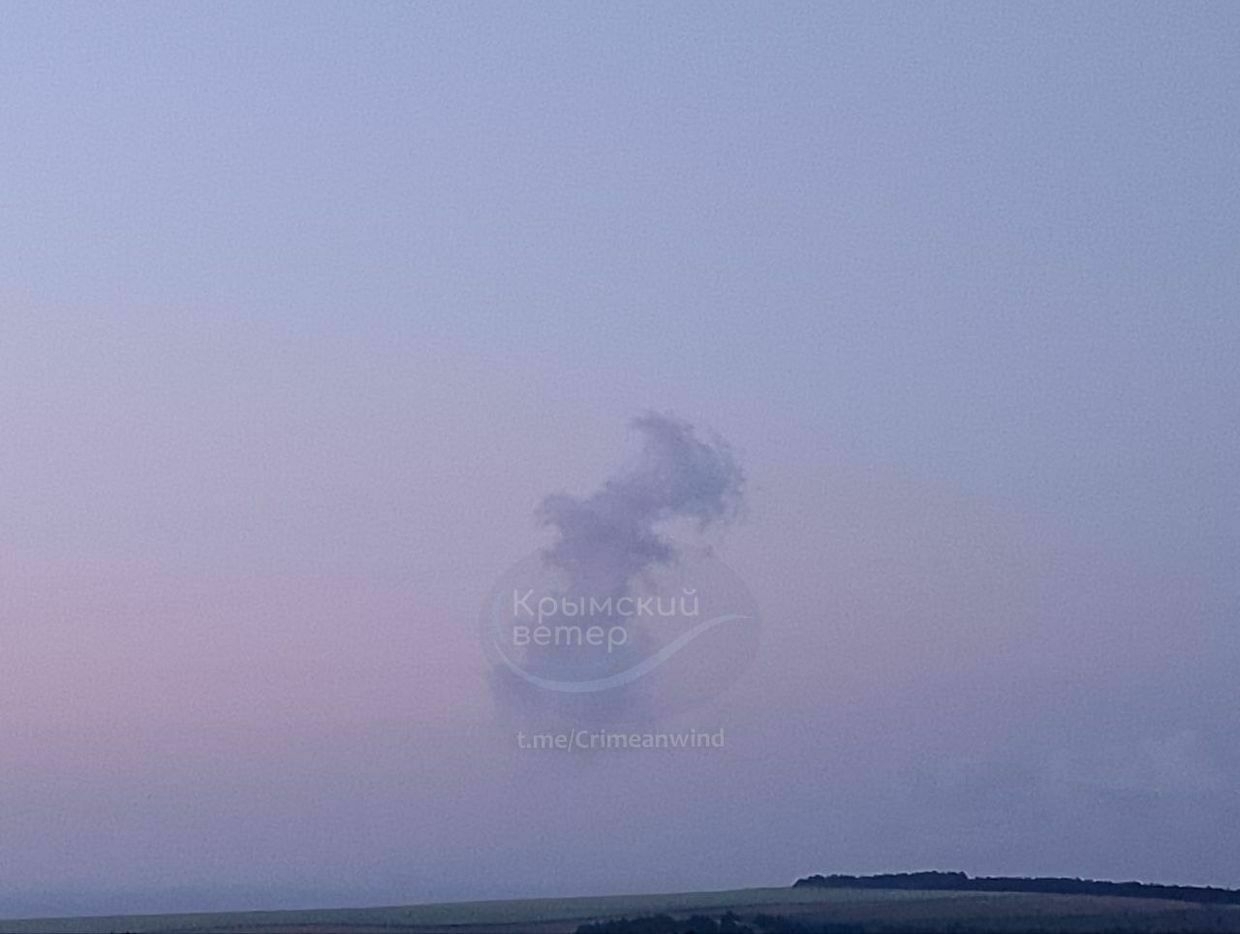
-
Russian attacks kill at least 3, injure 10 across Ukraine over past day
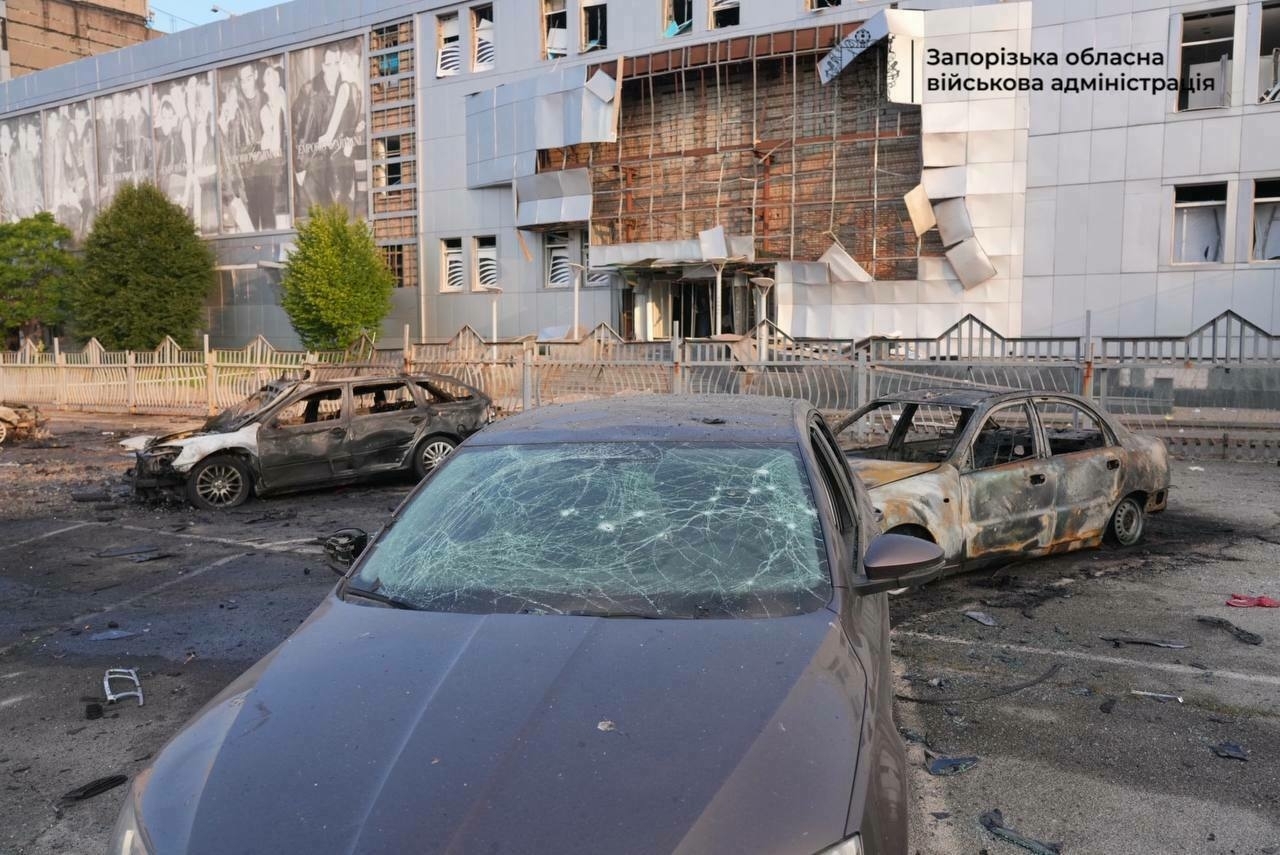
At least three people were killed and 10 injured in Russian attacks across Ukraine over the past day, Ukrainian officials said on June 14.
According to Ukraine’s Air Force, Russia launched 58 attack drones, primarily Shahed-type UAVs, and decoys from multiple directions. Air defenses destroyed 43 of the drones.
In Donetsk Oblast, one civilian was killed and two others were injured in Russian shelling of Yablunivka, Governor Vadym Filashkin said. Russian forces attacked settlements in the region 27 times over the past day.
In Kherson Oblast, five people were injured as Russia struck 23 settlements with drones, artillery, and airstrikes, Governor Oleksandr Prokudin reported. Residential buildings in Kherson city, Antonivka, and other towns were damaged, including a multi-story apartment block, six houses, a gas station, and some vehicles.
In Zaporizhzhia Oblast, at least one person was killed and three others injured in attacks targeting Zaporizhzhia and Polohy districts, Governor Ivan Fedorov said. Russian forces launched 438 strikes on 16 settlements, including 11 airstrikes and 266 drone attacks, mainly using FPV (first-person view) drones.
In a morning strike on Zaporizhzhia, more than 10 cars were burned at a parking lot, and at least 15 buildings were damaged. One person was injured.
According to Radio Free Europe/Radio Liberty, the Russian attack also destroyed a humanitarian aid warehouse in Zaporizhzhia. Over 100 metric tons of humanitarian supplies reportedly burned in the fire. The aid had recently arrived in five trucks and was intended for displaced people and residents of front-line areas. The damage is estimated at around $3 million.
Putin announces creation of separate drone branch in Russian military“We have accumulated a great deal of experience to create this branch of the armed forces,” Russian President Vladimir Putin said.The Kyiv IndependentTim Zadorozhnyy
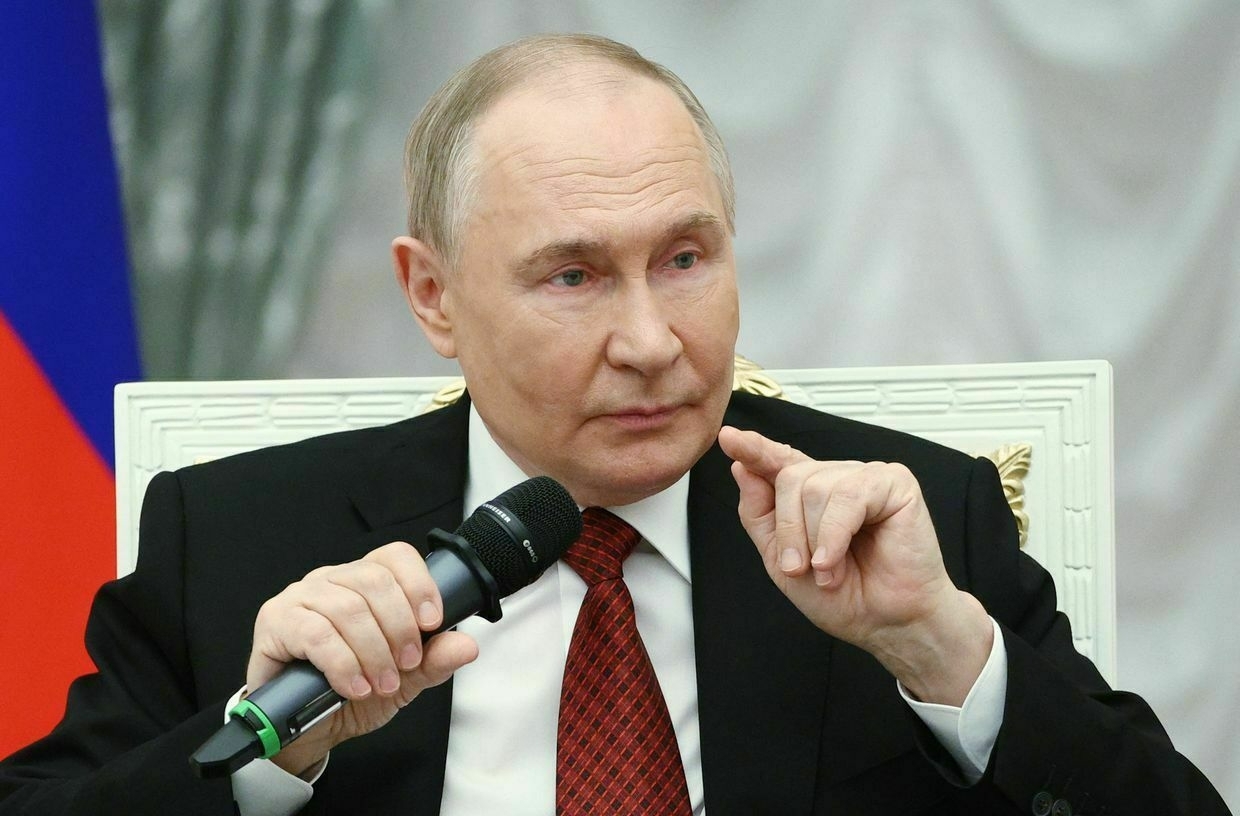
-
General Staff: Russia has lost 1,002,690 troops in Ukraine since Feb. 24, 2022
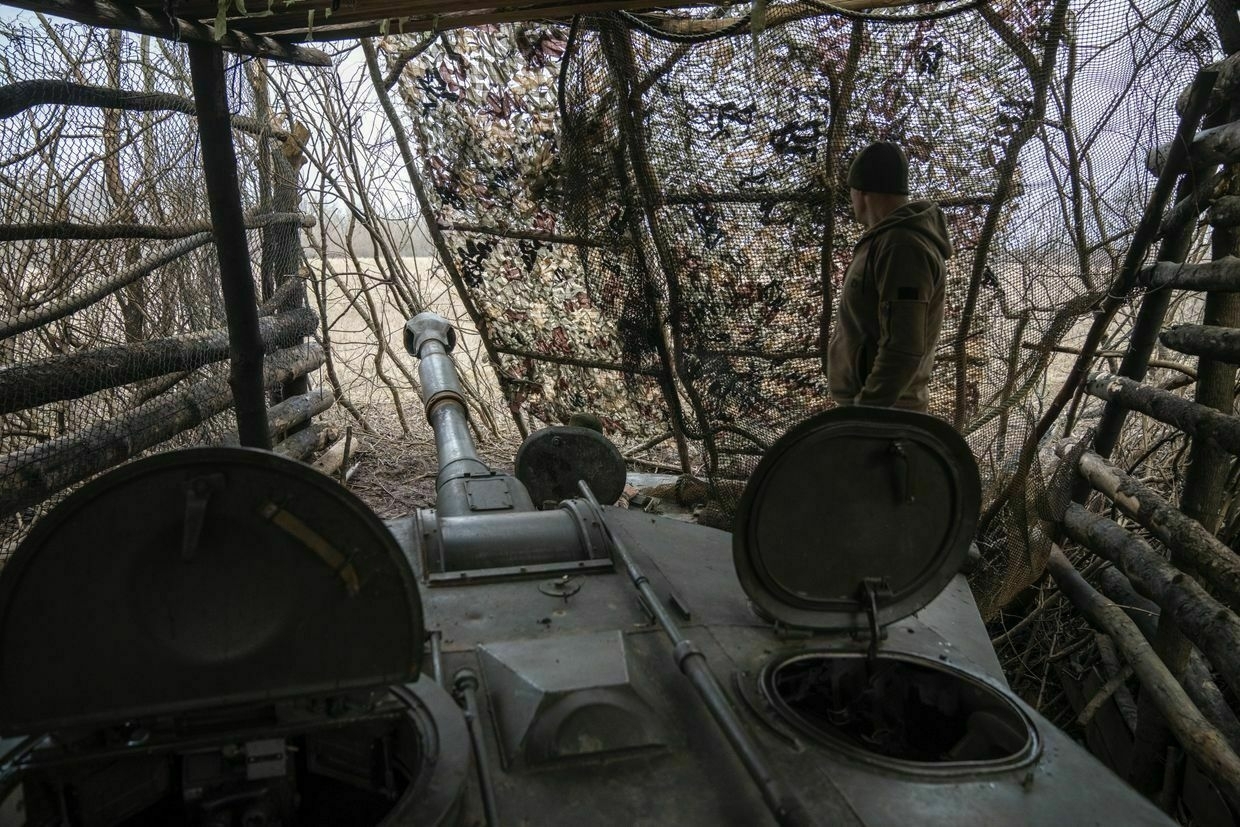
Russia has lost 1,002,690 troops in Ukraine since the beginning of its full-scale invasion on Feb. 24, 2022, the General Staff of Ukraine’s Armed Forces reported on June 14.
The number includes 1,130 casualties that Russian forces suffered just over the past day.
According to the report, Russia has also lost 10,937 tanks, 22,798 armored fighting vehicles, 51,928 vehicles and fuel tanks, 29,157 artillery systems, 1,417 multiple launch rocket systems, 1,185 air defense systems, 416 airplanes, 337 helicopters, 40,586 drones, 3,337 cruise missiles, 28 ships and boats, and one submarine.
As Russian losses in Ukraine hit 1 million, Putin’s war economy heads toward breaking pointRussian losses in Ukraine hit a massive, and grim milestone on June 12 — 1 million Russian soldiers killed or wounded during the 39-month-long full-scale war, according to figures from Kyiv. Although hugely symbolic, the number is unlikely to prompt a change in tactics from Moscow as it gears up forThe Kyiv IndependentChris York

-
US opposes lowering G7 cap on Russian oil, Bloomberg reports
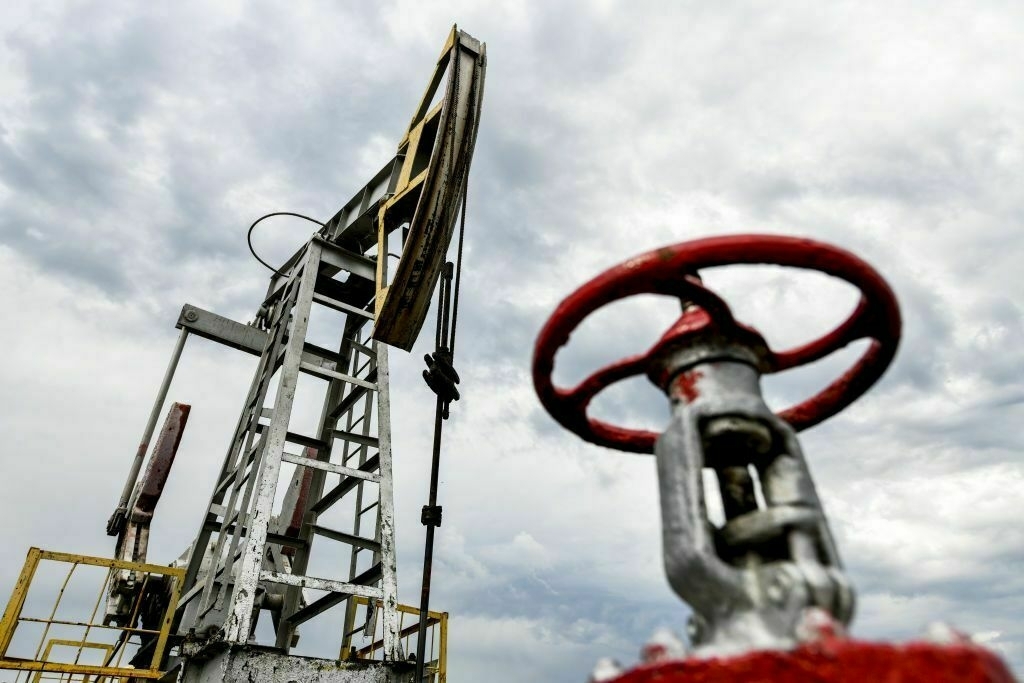
The United States is opposing a proposal by other Group of Seven nations to lower the price cap on Russian oil, Bloomberg reported on June 13.
Citing unnamed sources, Bloomberg said the U.S. remains opposed to reducing the cap from $60 to $45 per barrel – a position it first took earlier this year when Treasury Secretary Scott Bessent declined to support a similar effort.
The price cap, introduced in December 2022 as a measure to limit the Kremlin’s ability to finance its war against Ukraine, prohibits Western companies from shipping, insuring, or otherwise servicing Russian oil sold above $60 per barrel.
Despite U.S. resistance, the European Union and United Kingdom – backed by other European G7 countries and Canada – have said they are prepared to move forward with the proposal, even without Washington’s endorsement.
One source told Bloomberg that the EU and U.K. could explore lowering the cap without the U.S., as most of Russia’s oil is transported in European waters. However, a unified G7 agreement would carry greater impact if it could be enforced by the U.S.
The price cap debate has become more urgent as oil prices, which had fallen below the $60 cap in recent months, surged following Israel’s strikes against Iran in the past 24 hours.
G7 leaders will revisit the price cap discussion during the upcoming summit, hosted by Canada from June 15-17 in Kananaskis County, Alberta.
The summit agenda will also include topics such as support for Ukraine in the Russian war, global economic stability, digital transformation, and climate change.
The G7 currently includes Canada, France, Germany, Italy, Japan, the United Kingdom, and the United States. The European Union is also represented in the group.
Israel-Iran war could provide economic boost Russia needs to continue fight against UkraineIsrael’s “preemptive” strikes against Iran targeting the country’s nuclear program and killing top military officials could have far-reaching implications for Ukraine and could boost Russia’s ability to continue its full-scale invasion, experts have told the Kyiv Independent. Iran has been one of Russia’s staunchest allies throughout the war, providing thousandsThe Kyiv IndependentChris York
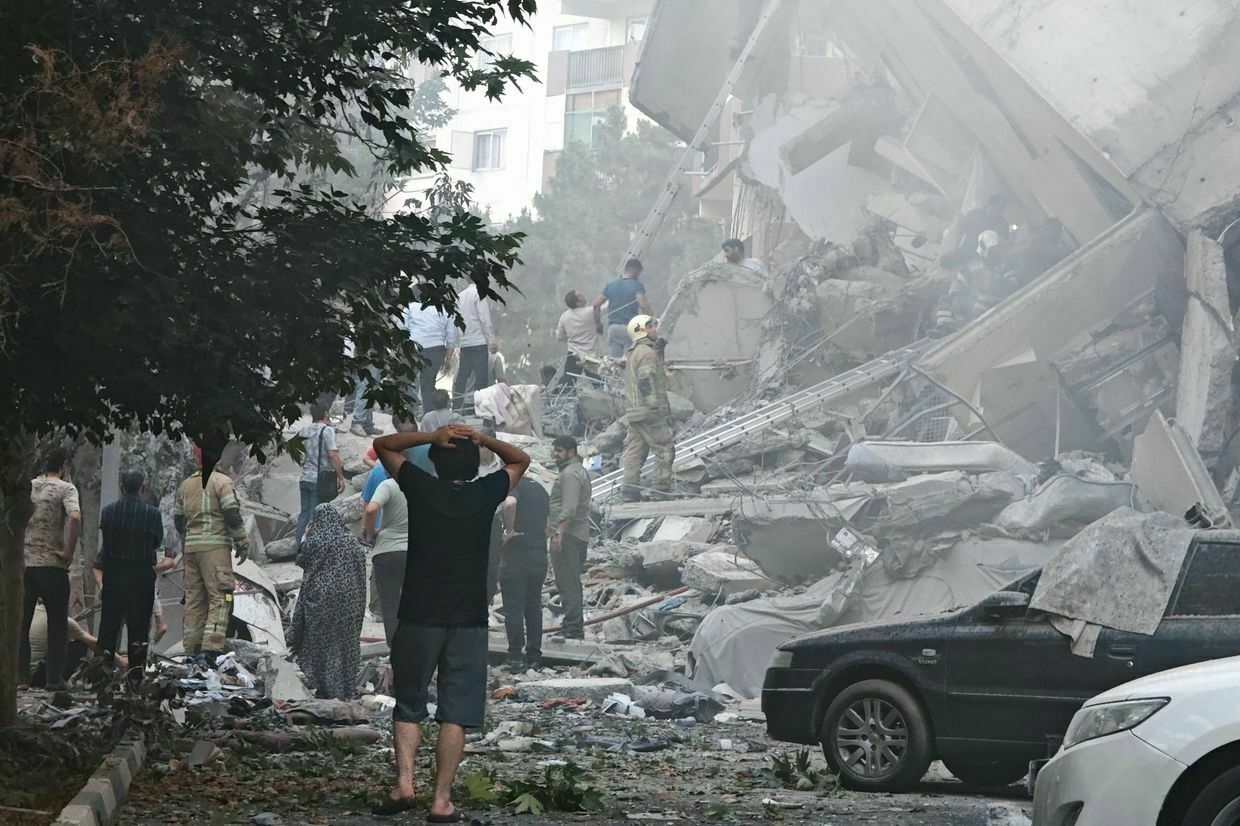
-
Three Ukrainians killed in bus accident in France, Zelensky confirms
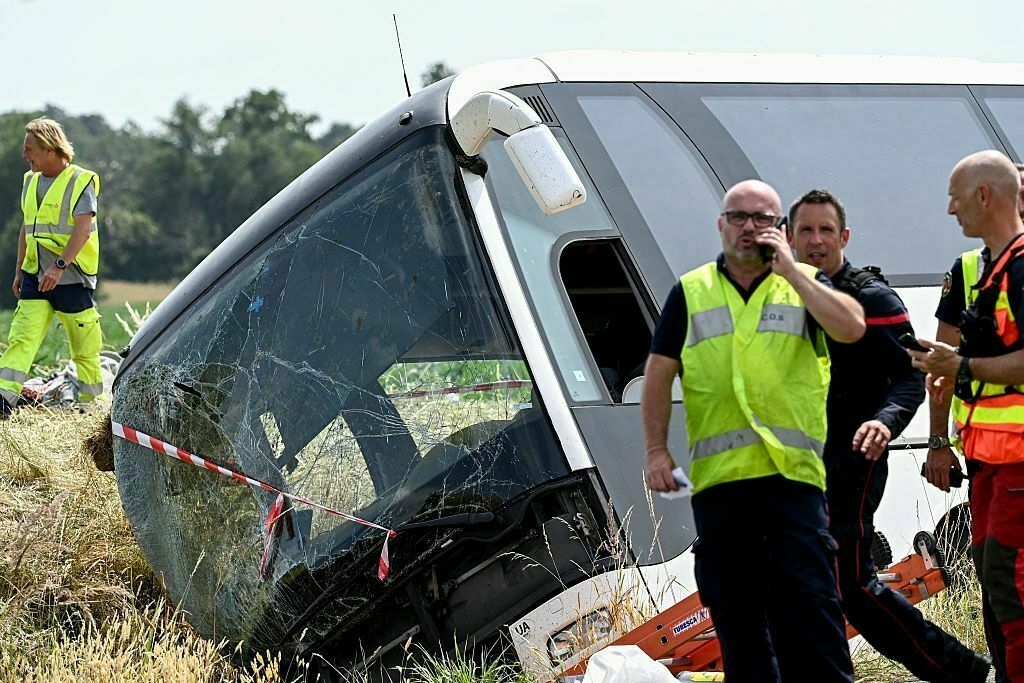
Three Ukrainian nationals were killed in a bus accident in France on June 13, President Volodymyr Zelensky confirmed in a statement on Telegram.
“Terrible news about the tragic bus accident in France,” Zelensky wrote.
The accident occurred in the morning of June 13, near the Sarthe department of France. The bus was reportedly carrying Ukrainian nationals, including adults and children, who were returning from an educational exchange.
While en route to Paris, the bus lost control and flipped into a ditch.
Four adults were killed in total – three of whom were Ukrainian nationals. French media reported that nine people sustained serious injuries, while an additional 18 suffered minor injuries.
Zelensky added that Ukraine’s Foreign Ministry promptly sent a team of diplomats and consuls, led by the ambassador to France, to assist survivors and support the victims’ families. The team is coordinating with French authorities and emergency services at the scene.
Foreign Minister Andrii Sybiha and Interior Minister Ihor Klymenko are providing regular updates on the victims' conditions and emerging details regarding the accident.
Zelensky thanked the French authorities, noting that “more than 50 emergency teams were deployed” in what he called “a true expression of French solidarity."
He also expressed his “condolences to all the families of the victims” and wished for a “speedy recovery of the injured children."Russian military equipment reportedly hit in Ukrainian drone attack against CrimeaThe Crimean Wind Telegram channel reported a hit in Simferopol, Crimea’s capital, sharing a photo of a plume of smoke rising in the vicinity of a local power station and of the village of Perevalne.The Kyiv IndependentMartin Fornusek

-
Ukraine's Sapsan ballistic missile to enter serial production following successful combat testing
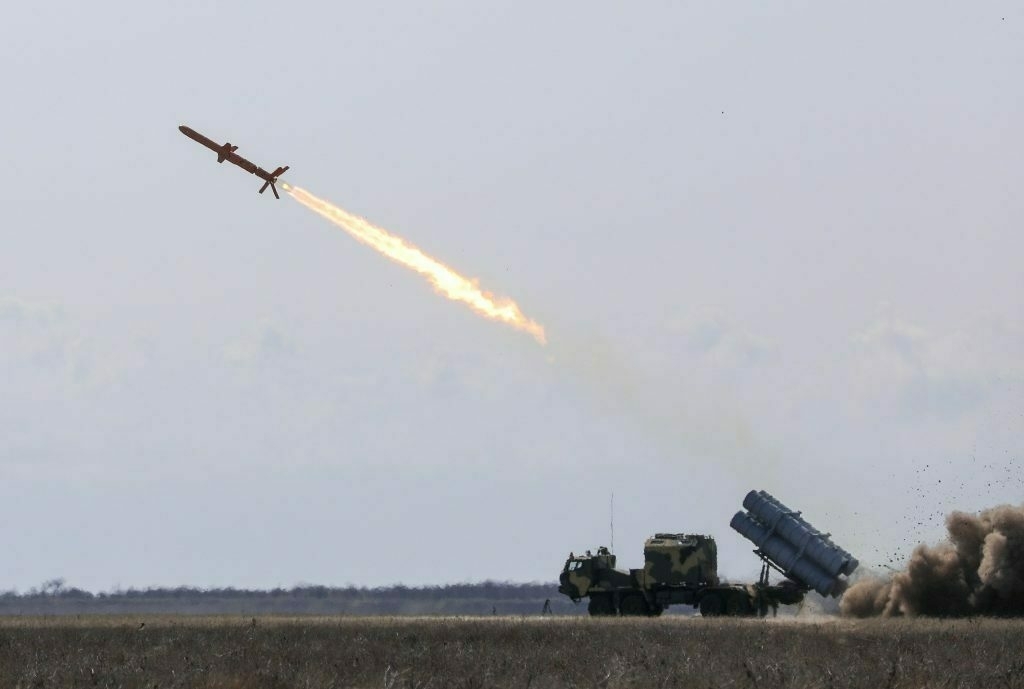
Ukraine’s domestically developed short-range Sapsan ballistic missile has successfully completed combat testing and is in the process of serial production, Ukrainian media reported on June 13.
The missile, with a payload of 480 kg, completed testing in May after successfully striking a Russian military target at a range of nearly 300 km, Valentyn Badrak, head of the an independent Ukrainian think Center for Army, Conversion and Disarmament Studies told Liga.net.
Ukraine’s Defense Ministry reportedly dedicated a department to formulate and test the missile.
There is no reported timeline as to when the missiles can be seen in regular use on the battlefield.
Domestically produced long-range weapons are of key importance to Ukraine’s defense strategy, as Western partners have been slow in delivering adequate weaponry amid increasing Russian attacks and offensives.
The news comes as U.S. Defense Secretary Pete Hegseth said in a congressional hearing on June 10 that the United States will reduce funding allocated for military assistance to Ukraine in its upcoming defense budget
In November 2024, President Volodymyr Zelensky announced that Ukraine has produced its first 100 missiles.
Since then, Ukraine has continued to increase domestic weapon production. Zelensky said on April 16 that over 40% of the weapons used at the front line are now produced in Ukraine, including over 95% of drones used at front line.
Zelensky also previously revealed that Ukraine had developed another domestic-made weapon, a missile-drone Palianytsia.
As Ukraine attempt to increase its defense production, Russia has continued to unleash large-scale attacks on Ukrainian cities, regularly launching hundreds of drones to overwhelm Ukrainian air defenses.
Ukraine’s military intelligence (HUR) shared with the Kyiv Independent that Russia’s production of ballistic missiles has increased by at least 66% over the past year.
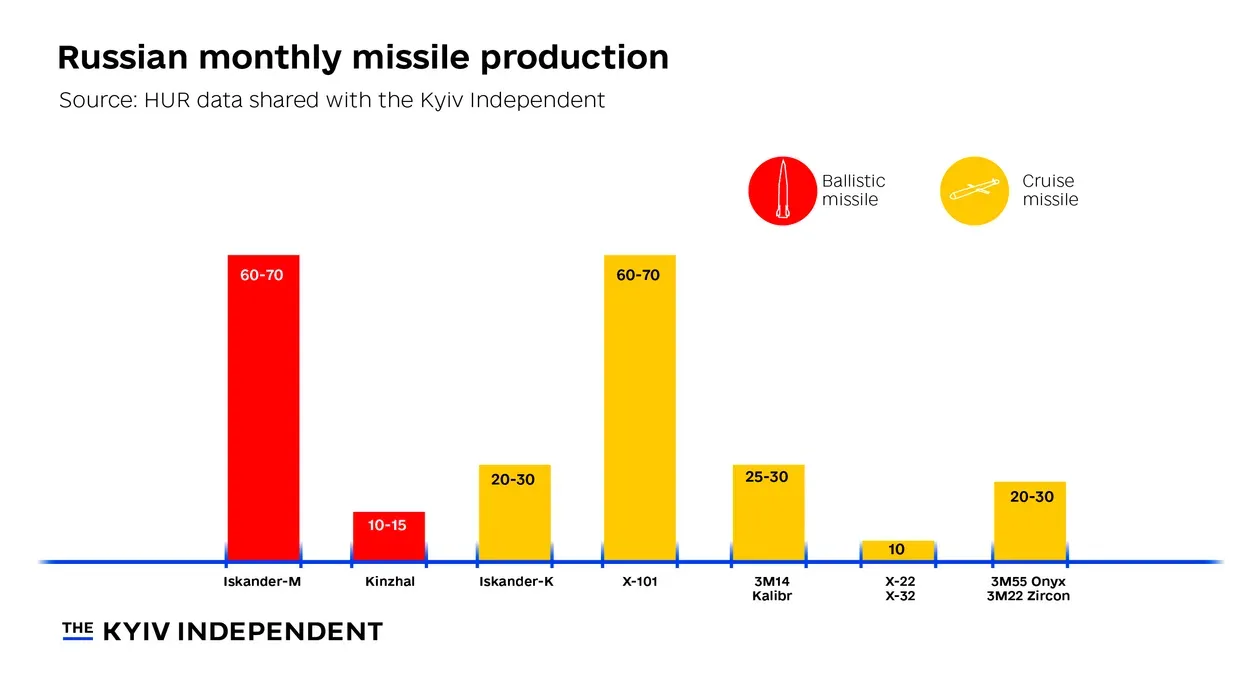
Russian monthly missile production (Nizar al-Rifai/The Kyiv Independent) Ukraine’s Defense Minister Rustem Umerov said in late 2024 that Ukraine also resumed and scaled up serial production of Neptune cruise missiles, modifying them to have a greater range.
Kyiv has received a number of long-range missiles from partners, such as U.S.-made ATACMS, British Storm Shadow, or French SCALP/T. Despite Ukrainian requests, German Defense Minister Boris Pistorius said on June 12 that Berlin has no plans to provide Taurus long-range missiles to Kyiv.
Germany to supply new Iris-T air defense systems to Ukraine, rules out Taurus missilesGermany will deliver new IRIS-T air defense systems to Ukraine under a three-year supply plan, President Volodymyr Zelensky said during a joint press conference with German Defense Minister Boris Pistorius, who said Berlin has no plans to provide Taurus long-range missiles.The Kyiv IndependentTim Zadorozhnyy
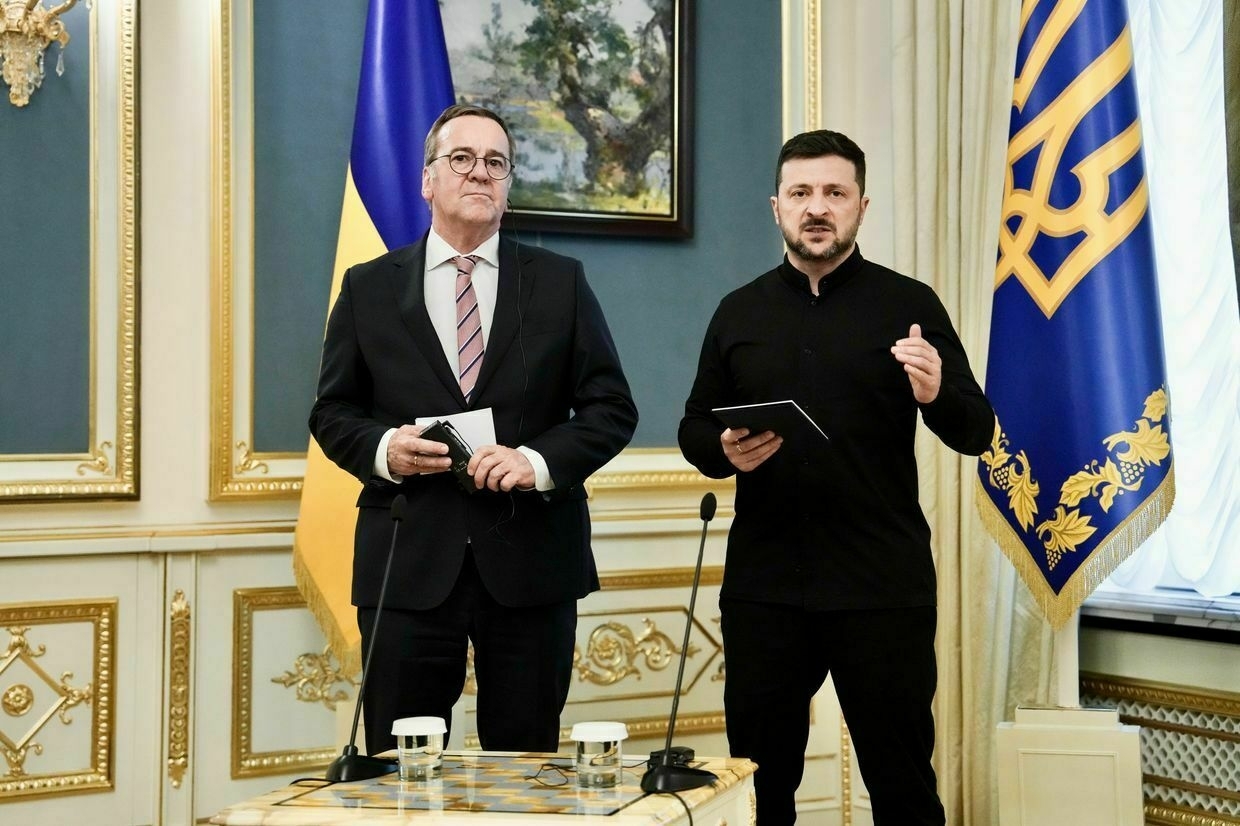
-
Russian Su-25 jet reportedly crashes in Donetsk Oblast
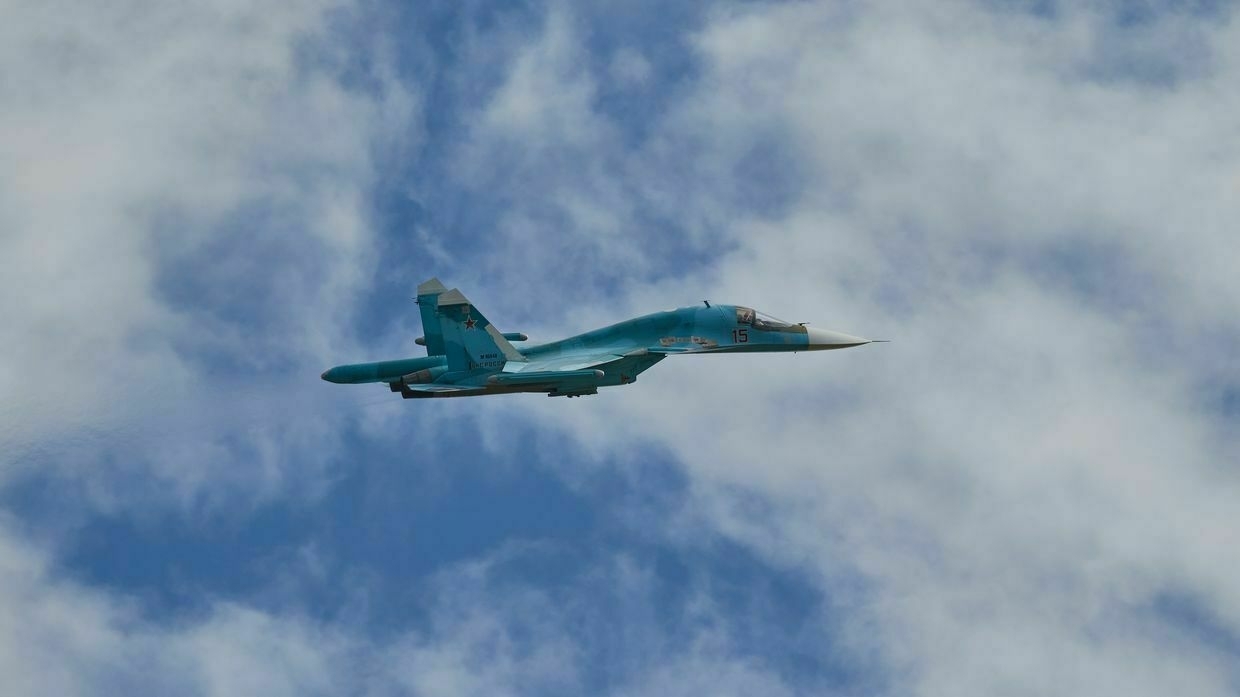
Editor’s note: This is a developing story and is being updated.
A Russian SU-25 fighter jet reportedly crashed over Donetsk Oblast on June 13, Russian social media channels reported.
Videos posted on social media of the purported crash by bloggers with close ties to the Russian Air Force appear to show the plane crashing into a field after closely being followed by another fighter jet. The circumstances of the crash remain unclear as rumours swirl of Russian ‘friendly fire’ as a potential cause of the crash.
The Kyiv Independent cannot independently verify the crash or the details surrounding it. Neither the Ukrainian nor Russian military have commented on the reported crash.
The Su-25, a Soviet-designed close-air support aircraft developed by Sukhoi in the late 1970s, is built for battlefield survivability. It features heavy armor and can withstand enemy fire.
The aircraft has been widely used in various conflicts, including in Afghanistan, Chechnya, and, more recently, in Ukraine, where both Russian and Ukrainian forces operate the platform.
Ukraine has downed multiple Russian Su-25s throughout the war. On Feb. 8, Ukraine’s military reported shooting down a Russian Su-25 near the town of Toretsk in Donetsk Oblast.
In another instance, Russia’s Defense Ministry said on on March 24 that Russian Su-25 attack aircraft crashed during a routine training flight in Primorye Krai in Russia’s Far East.
The incident comes less than two week following Ukraine’s ‘Operation Spiderweb’ in which Ukrainian drones smuggled deep inside Russia and hidden inside trucks struck as many as 41 Russian heavy bombers at four airfields across the country.
Ukraine war latest: Ukrainian MiG-29 strikes Russian drone hub, ammo depot in Zaporizhzhia direction, releases videoKey developments on June 13: * Ukrainian MiG-29 strikes Russian drone hub, ammo depot in Zaporizhzhia direction, releases video * Ukrainian military denies NYT claims about Russian presence in Dnipropetrovsk Oblast * Russia preparing strategic reserves for conflicts beyond Ukraine, Ukraine warns * Ukraine repatriates bodies of 1,200 citizens, soldiers under Istanbul dealThe Kyiv IndependentThe Kyiv Independent news desk
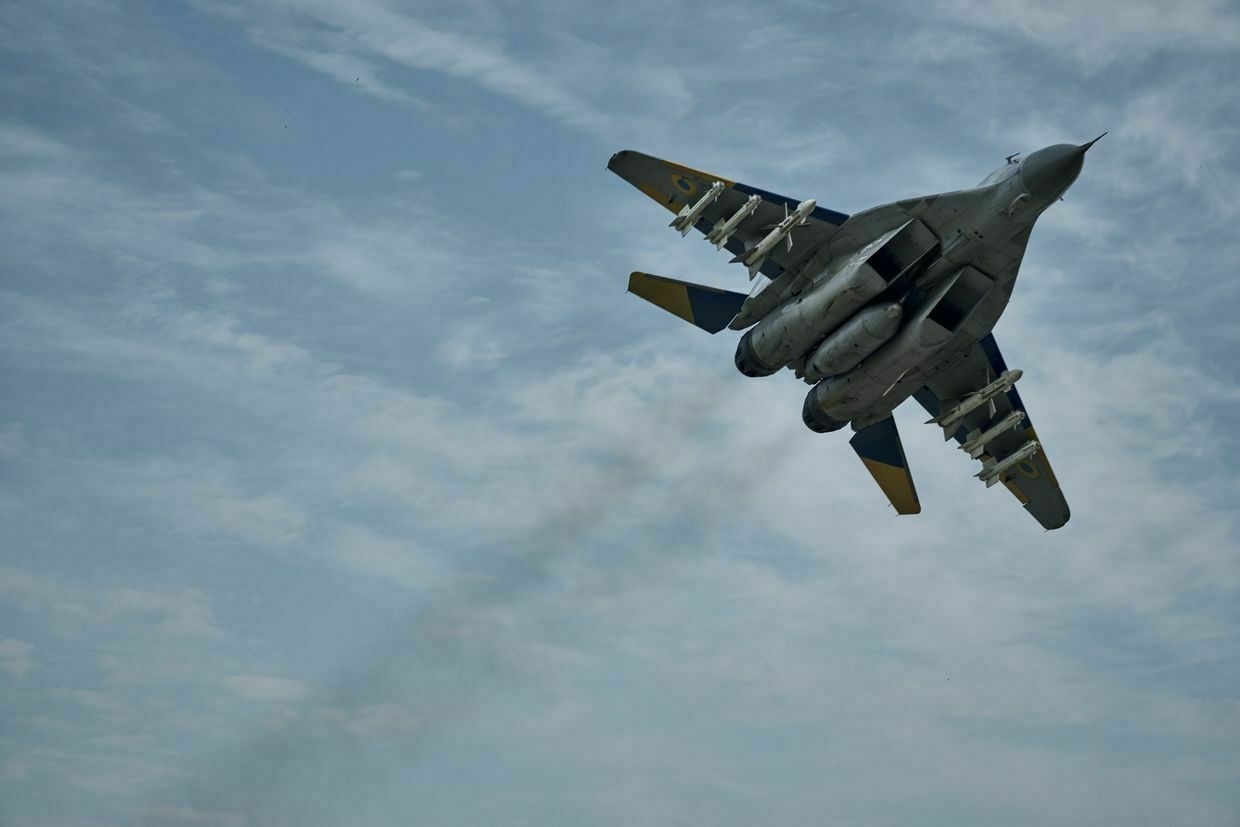
-
Iran retaliates by launching 'hundreds' of missiles towards Israel, injuring at least 7
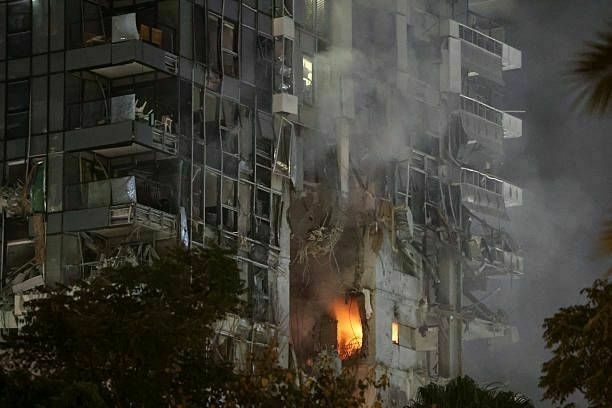
Editor’s note: This is a breaking story and is being updated.
Iran launched ‘hundreds’ of ballistic missiles towards Israel late on June 13, Iranian state media reported, as Tehran continues it retaliatory attacks in response to Israel’s strikes on Iran’s nuclear program.
At least seven people were injured near the city Tel Aviv as a result of the attack.
The drone attack follows heavy air strikes launched by Israel against Iran, targeting the country’s nuclear program and reportedly killing Hossein Salami, the commander-in-chief of the Islamic Revolutionary Guard Corps (IRGC), and other top officials.
Earlier in the day, Iran launched over 100 drones against Israel, all of which were intercepted outside of Israeli airspace, Ynet News reported on June 13, citing an Israeli military spokesperson.
U.S. President Donald Trump said earlier in the day that the U.S. military is on high alert and watching for any kind of retaliation, adding that the U.S. will respond to defend itself or Israel if Iran strikes back.
Before the attacks, Trump emphasized that despite tensions, he is committed to avoiding conflict and prefers a diplomatic solution to Iran’s nuclear aspirations. “I want to have an agreement with Iran,” Trump said, referring to ongoing Iran-U.S. nuclear talks in Oman.
Iran insists its nuclear program is for peaceful purposes and has expressed willingness to accept limited restrictions in exchange for the lifting of sanctions.
Beyond the Middle East, Iran has emerged as a key ally of Russia in its war against Ukraine, supplying Moscow with drones used in attacks on Ukrainian cities. Iran’s Islamic Revolutionary Guard Corps (IRGC) confirmed on June 13 that its aerospace commander, Amir Ali Hajizadeh, who led Iran’s Shahed drone supply to Russia, was killed in the strike on June 13.
Just hours after Russia launched its own missile and drone assault on Ukraine, Russian President Vladimir Putin decried the “numerous civilian casualties” in Iran and condemned Israel’s actions as violations of the UN Charter and international law.
Following the inital strikes by Israel, Kyiv expressed concern over the security situation in the Middle East after Israeli air strikes against Iran, but stressed that Tehran remains a “source of problems” in the region “and beyond."
Israel-Iran war could provide economic boost Russia needs to continue fight against UkraineIsrael’s “preemptive” strikes against Iran targeting the country’s nuclear program and killing top military officials could have far-reaching implications for Ukraine and could boost Russia’s ability to continue its full-scale invasion, experts have told the Kyiv Independent. Iran has been one of Russia’s staunchest allies throughout the war, providing thousandsThe Kyiv IndependentChris York
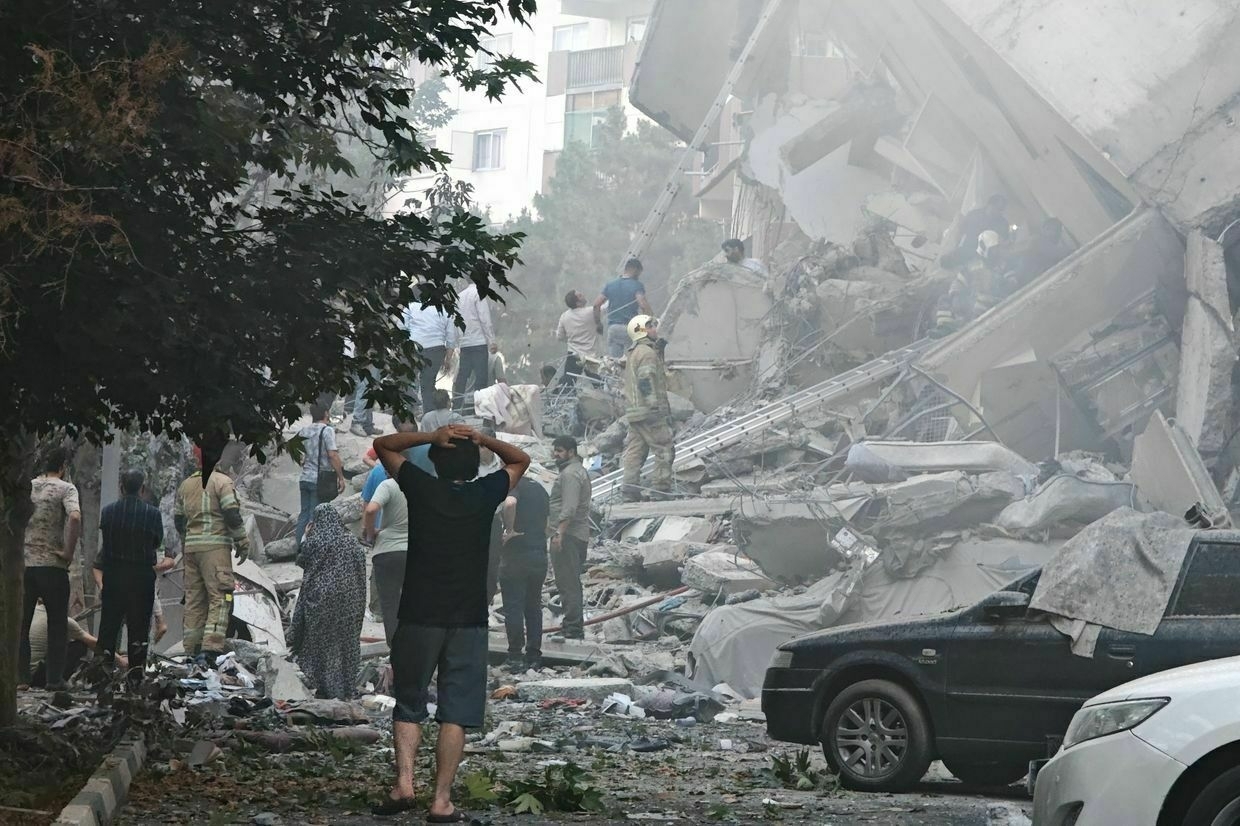
-
Ukraine war latest: Ukrainian MiG-29 strikes Russian drone hub, ammo depot in Zaporizhzhia direction, releases video
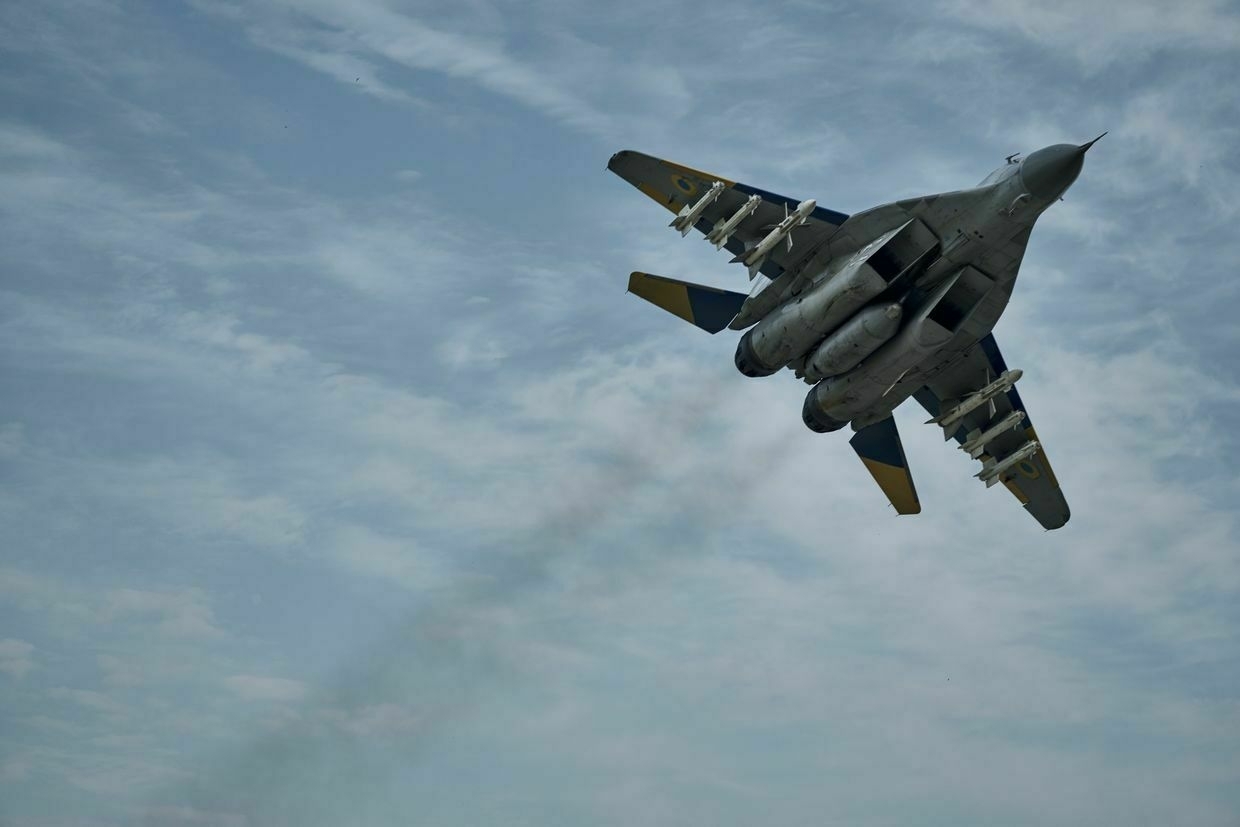
Key developments on June 13:
- Ukrainian MiG-29 strikes Russian drone hub, ammo depot in Zaporizhzhia direction, releases video
- Ukrainian military denies NYT claims about Russian presence in Dnipropetrovsk Oblast
- Russia preparing strategic reserves for conflicts beyond Ukraine, Ukraine warns
- Ukraine repatriates bodies of 1,200 citizens, soldiers under Istanbul deal with Russia
- Russian military equipment reportedly hit in Ukrainian drone attack against Crimea
A Ukrainian MiG-29 fighter jet carried out a precision strike on Russian positions in the Zaporizhzhia direction, targeting a command post for drone operators and a combined ammunition and fuel depot, Ukraine’s Air Force reported on June 13.
The Air Force did not disclose the exact location of the strike but thanked international partners for providing the guided munitions used in the attack.
“We thank our partners for their highly accurate and effective ‘arguments’,” the service wrote.
0:00/A Ukrainian MiG-29 fighter jet carried out a precision strike on Russian positions in the Zaporizhzhia area of southern Ukraine on June 13, 2025. (Ukraine’s Air Force / Telegram) The MiG-29, a Soviet-designed multirole fighter jet, remains a front-line platform in Ukraine’s air force and has been adapted to carry Western-supplied precision-guided weapons.
Zaporizhzhia Oblast, located in southeastern Ukraine, remains one of the war’s most contested areas. While the city of Zaporizhzhia is under Ukrainian control, southern parts of the region remain occupied by Russian forces.
Commander-in-Chief Oleksandr Syrskyi said on May 31 that Russia has intensified offensive operations across several key areas, including Zaporizhzhia, as part of a broader summer push.
Ukrainian forces have continued to conduct airstrikes and sabotage missions to degrade Russian supply lines and disrupt offensive preparations.
Israel-Iran war could provide economic boost Russia needs to continue fight against UkraineIsrael’s “preemptive” strikes against Iran targeting the country’s nuclear program and killing top military officials could have far-reaching implications for Ukraine and could boost Russia’s ability to continue its full-scale invasion, experts have told the Kyiv Independent. Iran has been one of Russia’s staunchest allies throughout the war, providing thousandsThe Kyiv IndependentChris York

Ukrainian military denies NYT claims about Russian presence in Dnipropetrovsk OblastThere is no confirmed information that Russian troops have entered Ukraine’s Dnipropetrovsk Oblast, spokesperson Victor Tregubov of the Khortytsia group of forces told Ukrainian media outlet Suspilne on June 13, refuting earlier claims published by the New York Times (NYT).
The NYT cited Ukrainian military sources claiming that Russian troops crossed the administrative boundary into Dnipropetrovsk Oblast for the first time since the war began.
The reporting also referenced a map by the Institute for the Study of War (ISW) indicating that Russian forces advancing in the region had allegedly secured a foothold.
Tregubov said the situation remains unchanged as of June 13. He indicated that no information suggests Russian forces have crossed the administrative border, but he noted that updated intelligence may be available later in the day.
Andrii Zadubiny, press officer of the Khortytsia forces, also rejected the claims.
“No enemy incursion into Dnipropetrovsk Oblast has been recorded. We refute this information,” he told Suspilne. He suggested that ISW might be relying on Russian sources.
On June 8, Russia’s Defense Ministry claimed that its forces had entered Dnipropetrovsk Oblast, a claim that has not been substantiated by Ukrainian authorities.
The Ukrainian monitoring group DeepState also reported no evidence of Russian forces entering the oblast. A map depicting Russian-occupied areas of Ukraine indicates that the Russian troops are only a couple of kilometers from the border.
To date, Dnipropetrovsk Oblast — a major industrial region in central Ukraine — has not seen confirmed Russian ground incursions, though it has remained under constant threat from missile and drone attacks.
In late April, Ukrainian authorities began mandatory evacuations of families with children from four front-line villages — Kolona Mezhova, Novopidhorodne, Raipole, and Sukhareva Balka — located just kilometers from Russian positions.
The latest developments come amid growing pressure on Ukrainian defenses across multiple fronts and continued failure of U.S.-mediated negotiations to produce a ceasefire agreement.
Why can’t the West match Russia’s ammunition production?Editor’s Note: This article has been updated to reflect new details of BAE Systems’ new chemical process that the company confirmed to the Kyiv Independent after initial publication. The West is failing to catch up to Russia’s production of the most basic unit of war for the past half-millennium — gunpowder.The Kyiv IndependentKollen Post
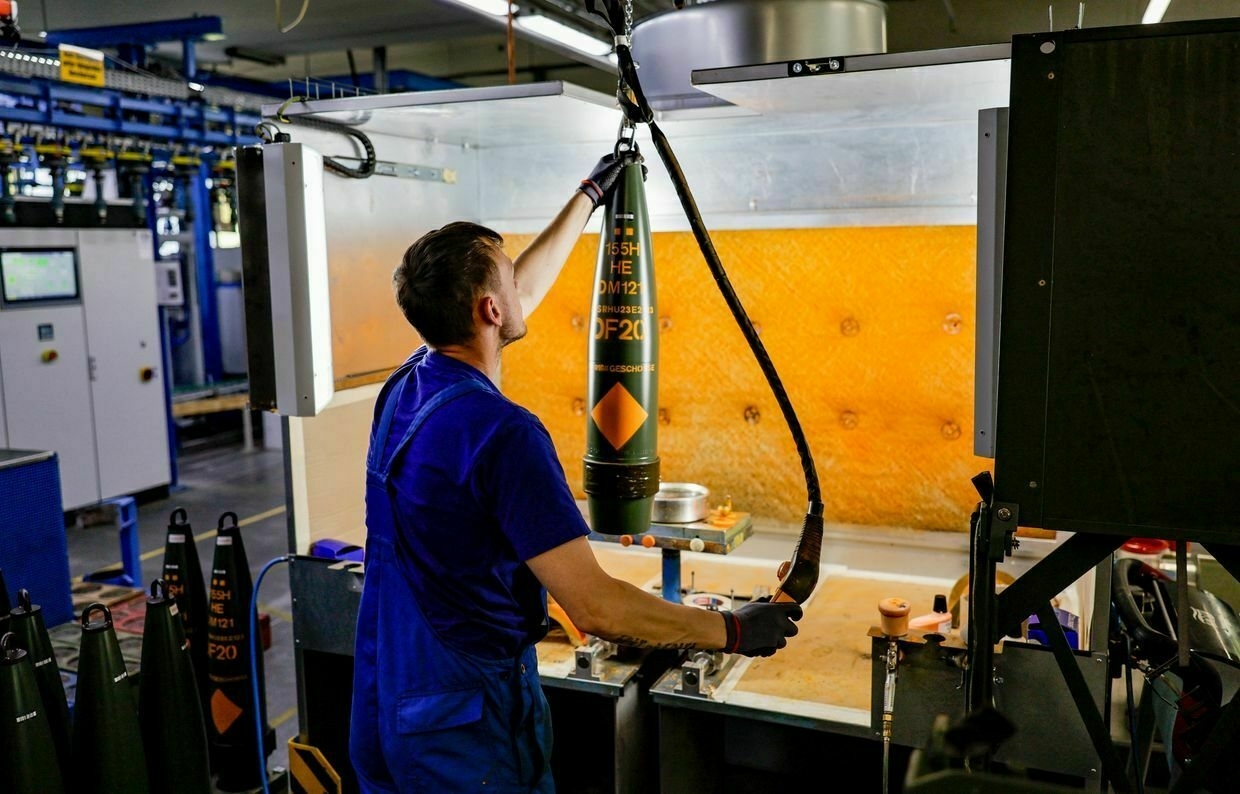
Russia preparing strategic reserves for conflicts beyond Ukraine, Ukraine warnsForeign Minister Andrii Sybiha warned on June 13 that Russia has begun preparing strategic military reserves, signaling plans for military operations that may extend beyond Ukraine.
“According to our intelligence, Russia has started to prepare strategic reserves, which indicates plans for combat operations not only in Ukraine,” Sybiha said during the Globsec conference in Prague, calling for urgent diplomatic and economic pressure.
“Allies need full diplomatic mobilization to stop this war. This is not just a question for Ukraine. (Russian President Vladimir) Putin only understands strength, and right now it’s crucial to apply sanctions in a timely manner, using them as economic weapons to pressure Russia,” Sybiha said.
The comments come as Russia intensifies its military offensives and missile strikes across Ukraine, despite participating in two recent rounds of peace talks in Istanbul. The first talks were held on May 16, followed by a second meeting on June 2. While both rounds produced agreements on prisoner exchanges, they failed to secure a ceasefire.
President Volodymyr Zelensky said in a June 12 interview with Germany’s Bild newspaper that Russia is using the talks to delay tougher U.S. sanctions, while continuing to escalate attacks on Ukrainian cities.
Russia also continues to issue nuclear threats to Western countries. Putin claimed on June 11 that Russia possesses the world’s most advanced nuclear systems, with 95% of its strategic nuclear forces reportedly made up of modern equipment.
Putin emphasized the need to significantly strengthen Russia’s ground forces. Russian defense spending has surged to 6.3% of GDP, the highest level since the Cold War, as Moscow continues to ramp up its military investment amid the ongoing war.
Iranian commander killed in Israeli airstrike oversaw Shahed drone supply to RussiaAmir Ali Hajizadeh was sanctioned by the European Union in 2022 for overseeing Tehran’s supply of Shahed-type drones to Russia.The Kyiv IndependentTim Zadorozhnyy
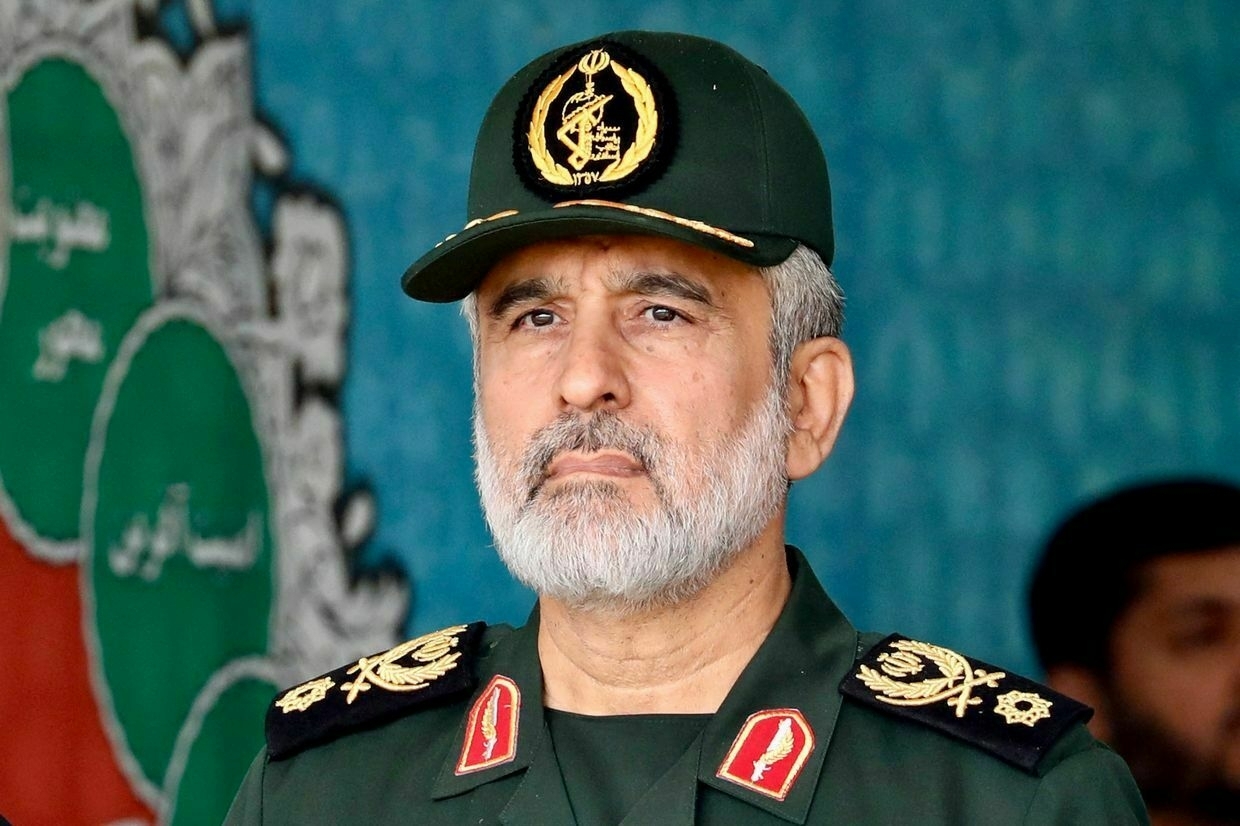
Ukraine repatriates bodies of 1,200 citizens, soldiers under Istanbul deal with RussiaUkraine has brought home the bodies of 1,200 Ukrainian soldiers and citizens as part of an agreement with Russia in Istanbul, the Coordination Headquarters for the Treatment of the Prisoners of War (POWs) announced on June 13.
The repatriation comes after Ukraine brought back the bodies of 1,212 fallen service members earlier this week, with Moscow voicing readiness to release the remains of some 6,000 Ukrainians total during recent peace talks in Istanbul.
The headquarters coordinated the operation with the Security Service of Ukraine (SBU), the Ombudsman’s Office, the military, the Interior Ministry, and other state and defense bodies. The International Committee of the Red Cross has also provided assistance.
It is not immediately clear whether Ukraine released the bodies of Russian soldiers in return. During the previous exchange on June 11, Moscow claimed it had repatriated the bodies of 27 Russian service members.
At the Istanbul meeting on June 2, Russian and Ukrainian delegations agreed on a new exchange of POWs but failed to reach a ceasefire agreement.
The talks led to the most extensive prisoner swap in late May, involving 1,000 captives on each side. The exchanges continued this week, focusing on severely ill and wounded soldiers.
Russia accused Ukraine on June 7 of failing to uphold a proposed prisoner exchange, a charge Kyiv denied. Russian media published footage showing refrigerated containers allegedly holding the bodies of Ukrainian soldiers, suggesting Kyiv had rejected their return.
POW Coordination Headquarters deputy head Andrii Yusov told Ukrainian Pravda that the footage had been filmed inside Russia and not at a designated exchange site.
Kyiv has repeatedly urged Moscow to adopt an “all-for-all” prisoner exchange formula. While over 5,000 Ukrainians have been returned from Russian captivity since March 2022, Russia continues to resist a comprehensive swap.
Amid Moscow’s war in Ukraine, Trump wonders why ‘everybody hates’ Russia“He (Russian President Vladimir Putin) fought with us in World War II… and now everybody hates Russia and loves Germany and Japan. It’s a strange world,” U.S. President Donald Trump said.The Kyiv IndependentAnna Fratsyvir
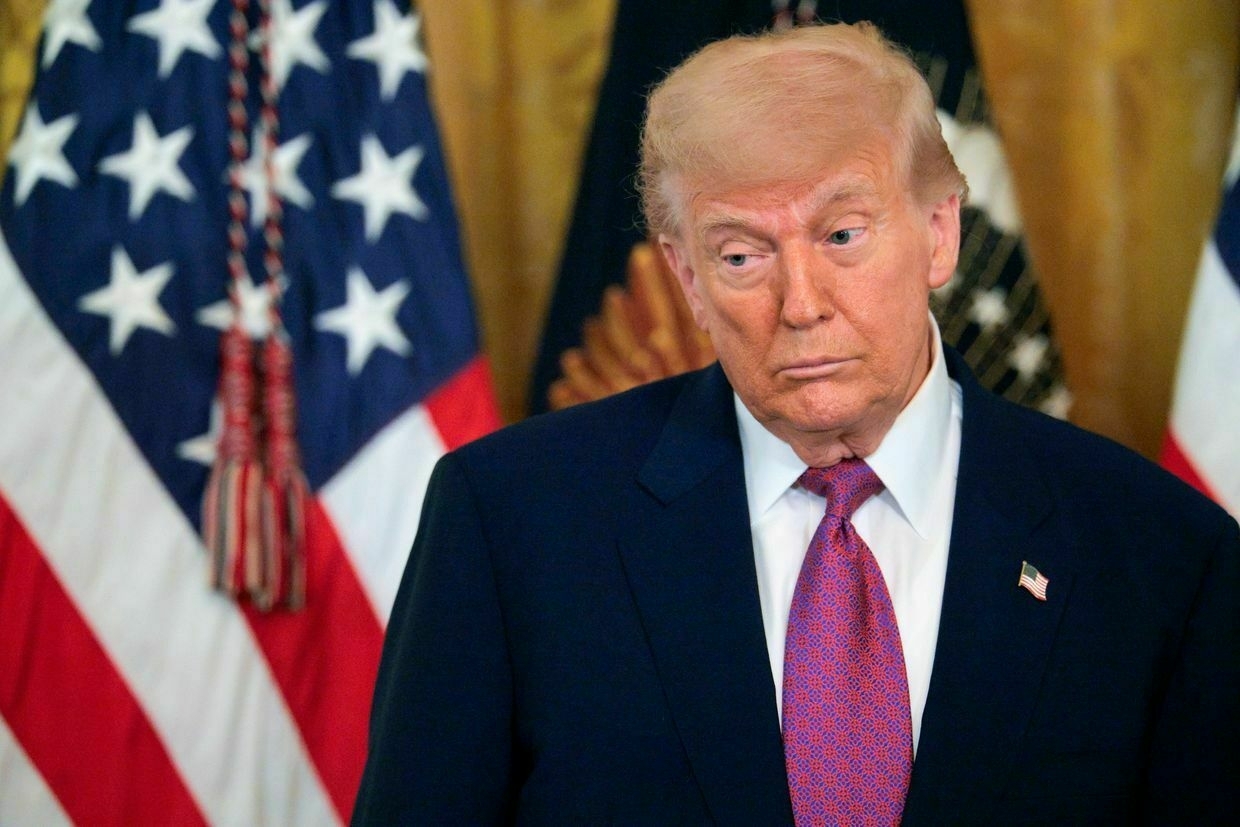
Russian military equipment reportedly hit in Ukrainian drone attack against CrimeaExplosions could be heard across Crimea early on June 13, including in Sevastopol and Simferopol, the Crimean Wind Telegram channel reported amid Russian claims of Ukrainian drone attacks.
Atesh partisans reported “precise hits” against Russian military facilities near Simferopol.
“Our agents report that due to the negligence of the (Russian) command, valuable equipment was damaged, probably an air defense missile system,” the group said on Telegram.
“There are also losses among the troops,” Atesh said, adding that the exact numbers are difficult to establish.
The pro-Ukrainian Crimean Wind Telegram channel reported a hit in Simferopol, Crimea’s capital, sharing a photo of a plume of smoke rising in the vicinity of a local power station and of the village of Perevalne. Blasts in Yevpatoriia, Saki, Fedosia, and elsewhere were also reported.
Russia’s Defense Ministry claimed its air defenses shot down 125 Ukrainian drones overnight on June 13, including 70 over Crimea and seven over the Black Sea. Russian officials did not comment on possible damage.
The Kyiv Independent could not verify the claims. Ukraine has not commented on the alleged attacks.
Russia has illegally occupied Crimea since 2014, transforming the peninsula into a heavily militarized stronghold to support its war against Ukraine.
Ukrainian forces have repeatedly targeted the peninsula with missiles and drones since the outbreak of the full-scale war in 2022. Most recently, Ukrainian drones attacked an ammunition depot used by Russia’s 126th Coastal Defense Brigade near the village of Perevalne.
Note from the author:
Ukraine War Latest is put together by the Kyiv Independent news desk team, who keep you informed 24 hours a day, seven days a week. If you value our work and want to ensure we have the resources to continue, join the Kyiv Independent community.
-
Without a hint of irony, Putin offers condolences for 'civilian casualties' in Iran, condemns Israel's 'violations' of UN Charter
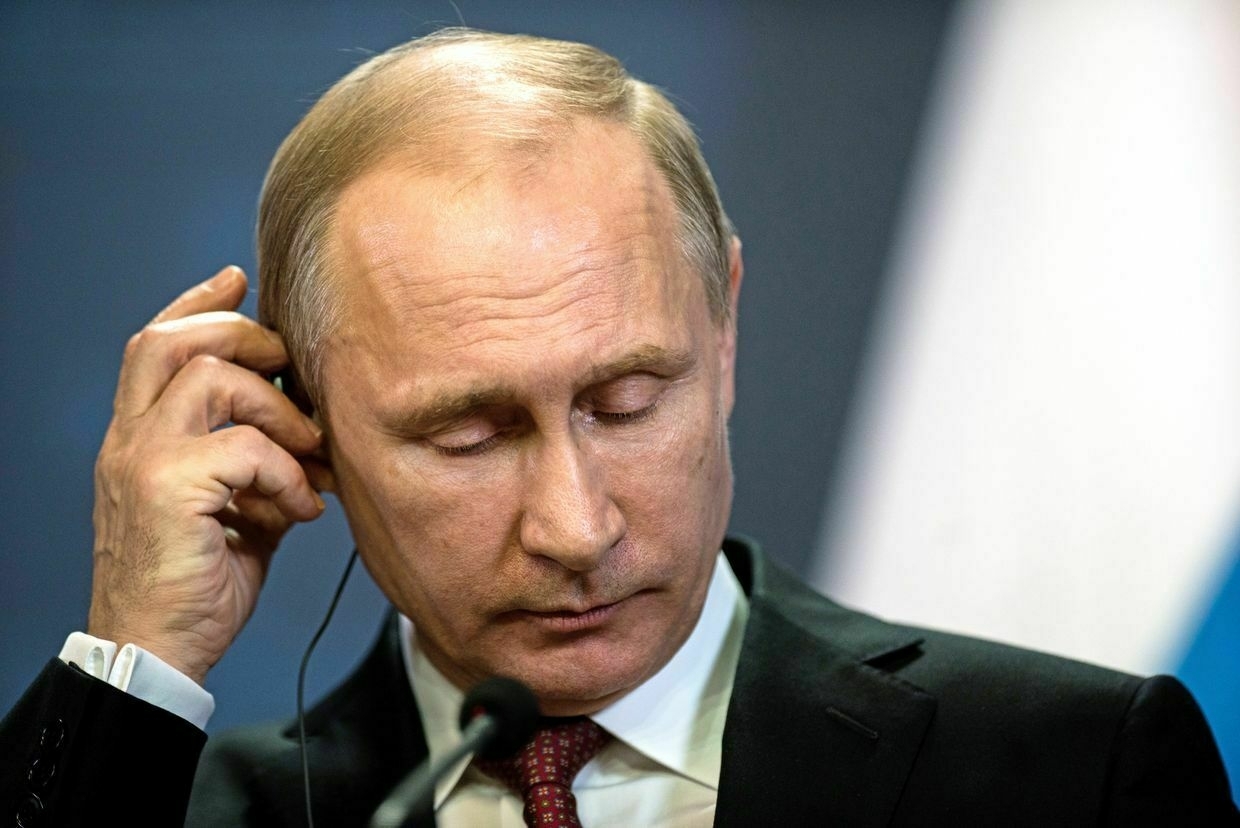
Russian President Vladimir Putin spoke separately with Iranian President Masoud Pezeshkian and Israeli Prime Minister Benjamin Netanyahu on June 13, amid a sweeping Israeli air assault on Iran that killed top military officials and targeted the country’s nuclear infrastructure.
The Israeli strike, described by Tel Aviv as “preemptive,” involved 200 aircraft and the release of 330 munitions on over 100 sites. Iran’s Islamic Revolutionary Guard Corps confirmed that several senior commanders were killed, including aerospace chief Amir Ali Hajizadeh.
During his call with Pezeshkian, Putin expressed condolences for what the Kremlin described as “numerous civilian casualties” and condemned Israel’s actions as violations of the UN Charter and international law.
The conversations took place just hours after Russia launched its own missile and drone assault on Ukraine. At least four civilians were killed and 24 injured in Russian attacks across multiple regions on June 13, according to Ukrainian officials.
Moscow has killed tens of thousands of Ukrainian civilians, and the true extent of the death toll is simply not known. Russia’s full-scale invasion of Ukraine was a clear and direct violation of both international law and the UN Charter.
During the conversation with Netanyahu, Putin emphasized “the importance of returning to the negotiation process,” and offered to mediate in the conflict.
The Russian leader, who has himself been indicted by the International Criminal Court for war crimes in Ukraine, also pledged Moscow’s support in “de-escalating the conflict."
Russia has deepened military and political ties with Tehran since the start of its full-scale war against Ukraine. Iran has supplied Moscow with thousands of Shahed-type attack drones and short-range ballistic missiles used in routine strikes on Ukrainian cities.
Ukraine’s Foreign Ministry responded to the Middle East escalation by expressing concern about broader regional instability but reiterated that “the Iranian regime supports Russia in its illegal war of aggression” and provides it with “weapons to kill Ukrainians."
Kyiv warned that the fallout could destabilize international security and trigger economic shocks. Global oil prices soared over 10% after the Israeli operation — a development that could enhance revenues for Russia, whose war budget is largely financed by energy exports.
Israel-Iran war could provide economic boost Russia needs to continue fight against UkraineIsrael’s “preemptive” strikes against Iran targeting the country’s nuclear program and killing top military officials could have far-reaching implications for Ukraine and could boost Russia’s ability to continue its full-scale invasion, experts have told the Kyiv Independent. Iran has been one of Russia’s staunchest allies throughout the war, providing thousandsThe Kyiv IndependentChris York
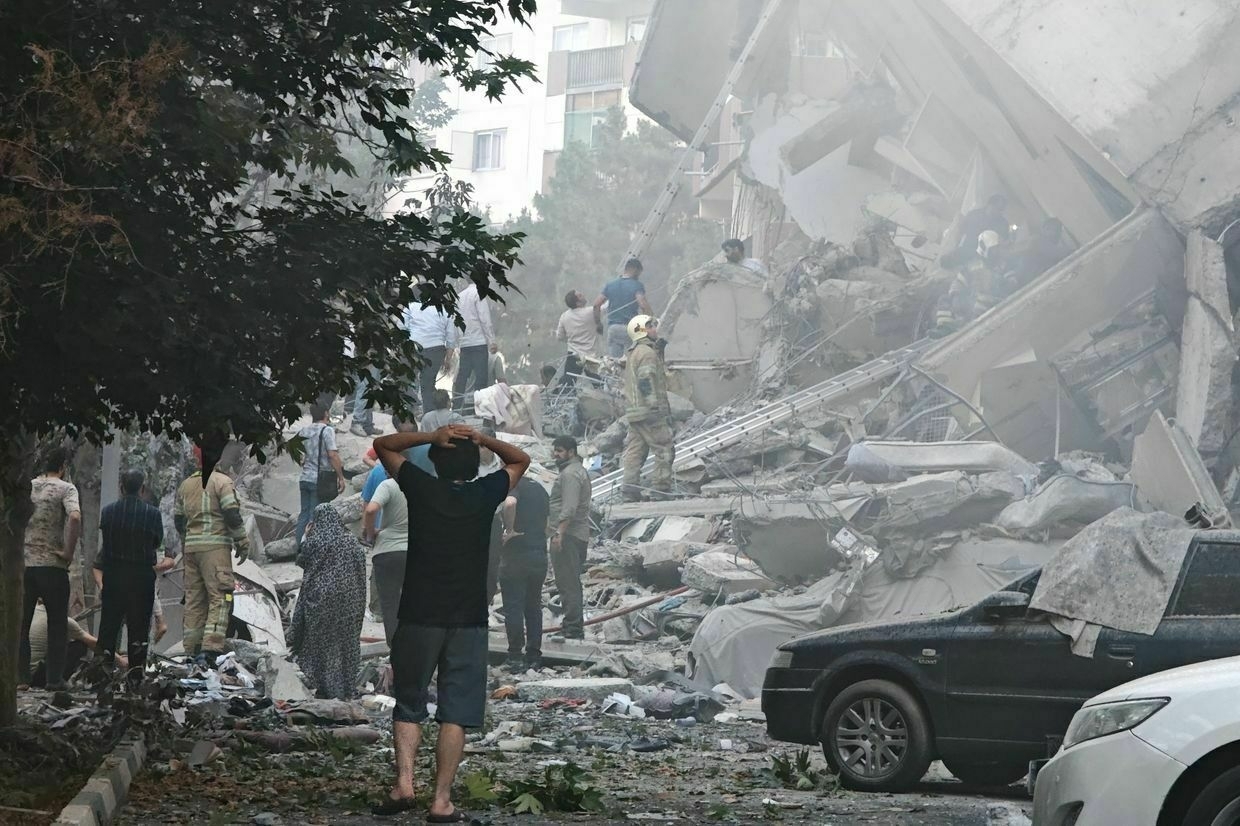
-
Drone warfare: how the Ukrainian “Bulava” outclasses Russian “Lancets” #shorts
-
British jets intercept Russian spy plane over Baltic Sea, Poland calls it NATO readiness test
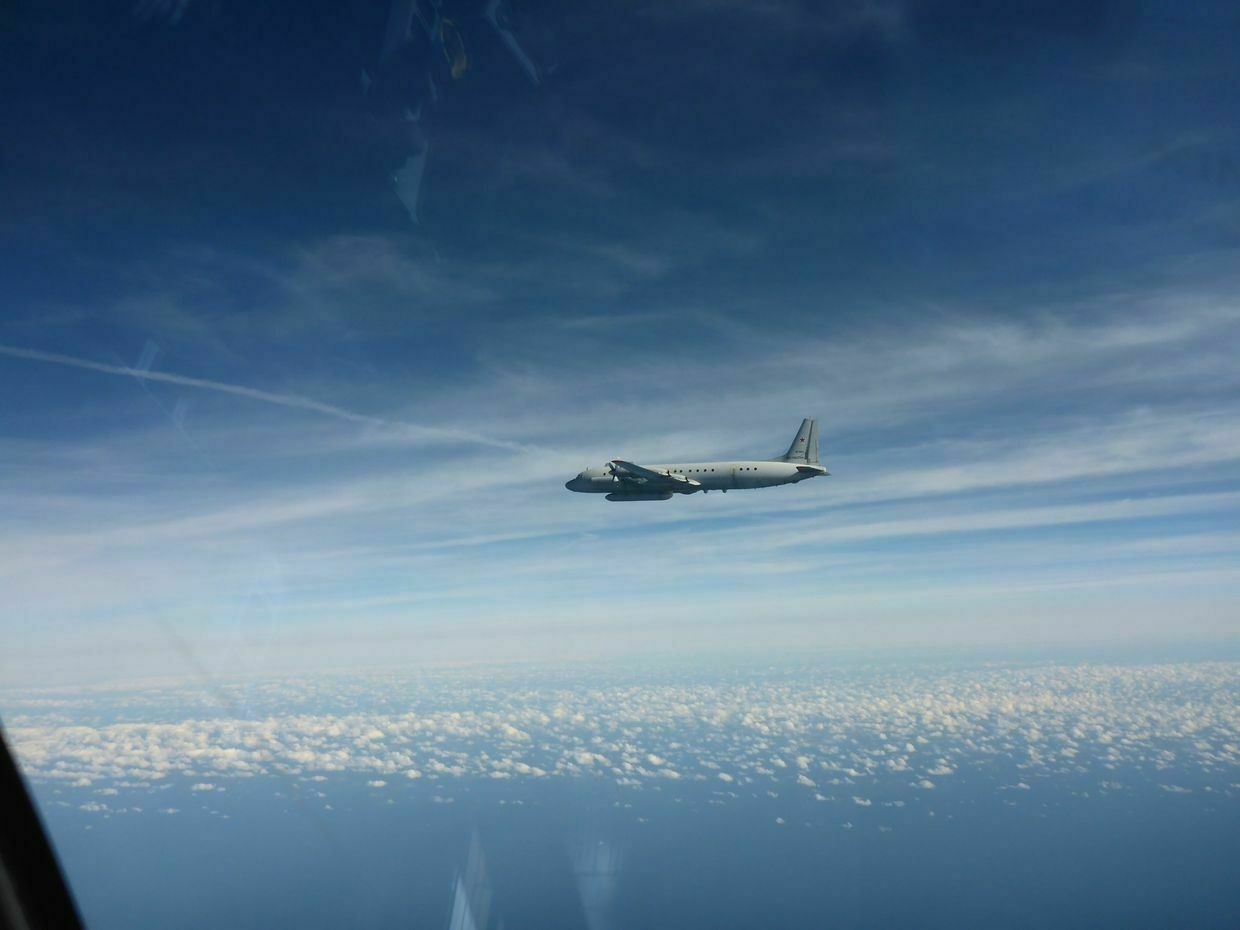
British fighter jets intercepted a Russian Il-20 reconnaissance aircraft that violated airspace over the Baltic Sea on the morning of June 13, Poland’s military command reported.
“This is another case of provocative testing of the readiness of NATO countries' systems,” the statement said, adding that NATO command structures are now analyzing the incident.
The Russian Il-20, based on the Il-18 transport aircraft, is used for electronic surveillance and reconnaissance missions. It is equipped with radar and signal intelligence gear designed to collect information on military infrastructure and communication networks.
According to the military command, the aircraft entered Baltic Sea airspace at approximately 10:50 a.m. and was promptly intercepted by two British fighter jets operating out of Poland.
No further details were disclosed about the exact location of the encounter or how long the Russian aircraft remained in restricted airspace.
The incident adds to a series of aerial provocations reported by NATO allies since the start of Russia’s full-scale invasion of Ukraine in 2022. Poland has repeatedly scrambled jets in response to Russian missile and drone attacks near its border.
On Feb. 11, a Russian Su-24MR reconnaissance aircraft flew into Polish airspace over the Bay of Gdansk for more than a minute. Moscow attributed the incursion to a navigational error, but Polish officials dismissed the claim as implausible.
Poland shares a long border with Ukraine and a northern coastline along the Baltic Sea, where Russia’s militarized Kaliningrad exclave is located.
Warsaw has repeatedly warned that Russia’s ongoing aerial provocations could lead to a dangerous escalation if not firmly countered.
How an Israel-Iran war could help Russia’s economy — and deprive Ukraine of weaponsIsrael’s “preemptive” strikes against Iran targeting the country’s nuclear program and killing top military officials could have far-reaching implications for Ukraine and could boost Russia’s ability to continue its full-scale invasion, experts have told the Kyiv Independent. Iran has been one of Russia’s staunchest allies throughout the war, providing thousandsThe Kyiv IndependentChris York
